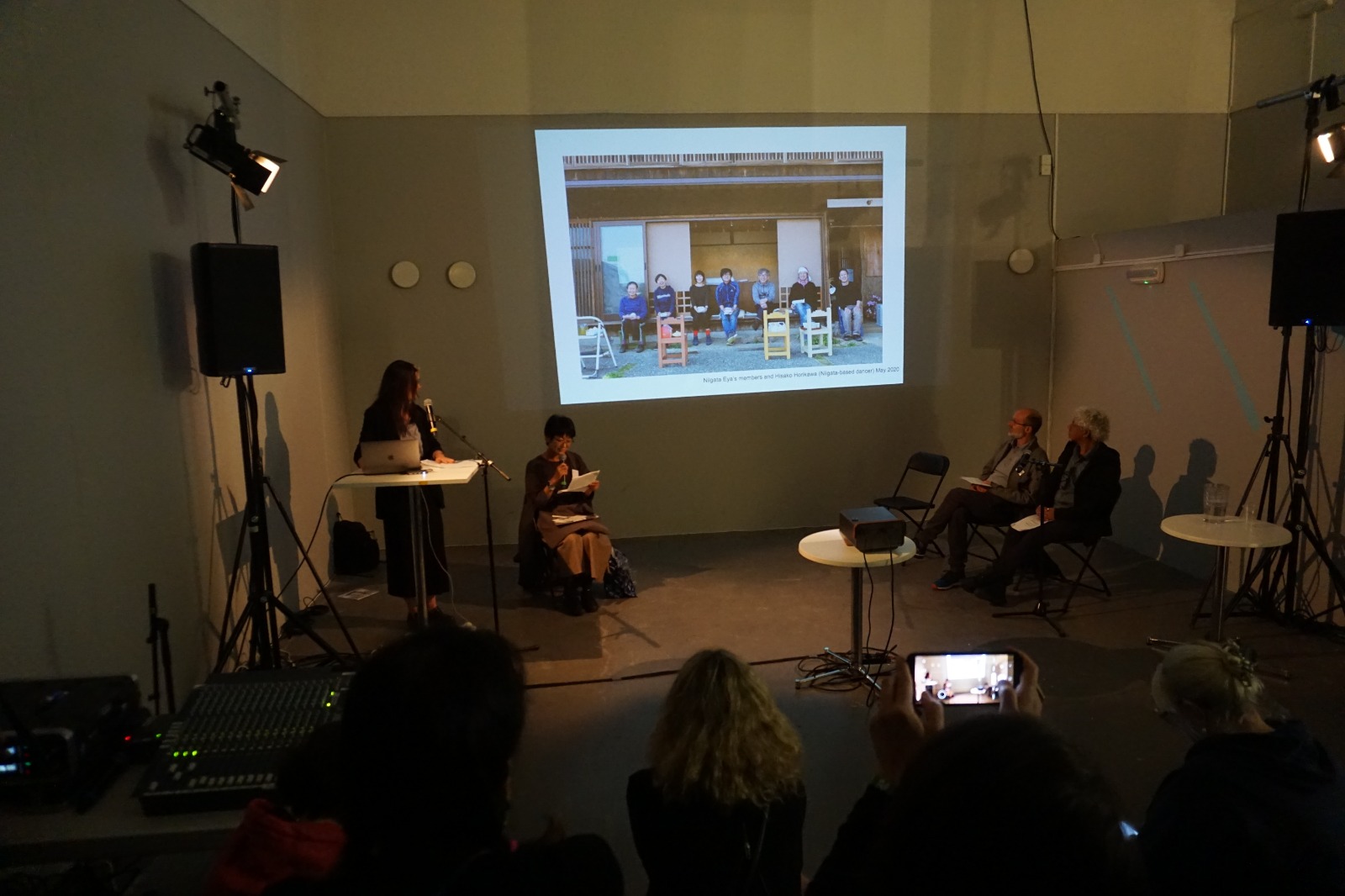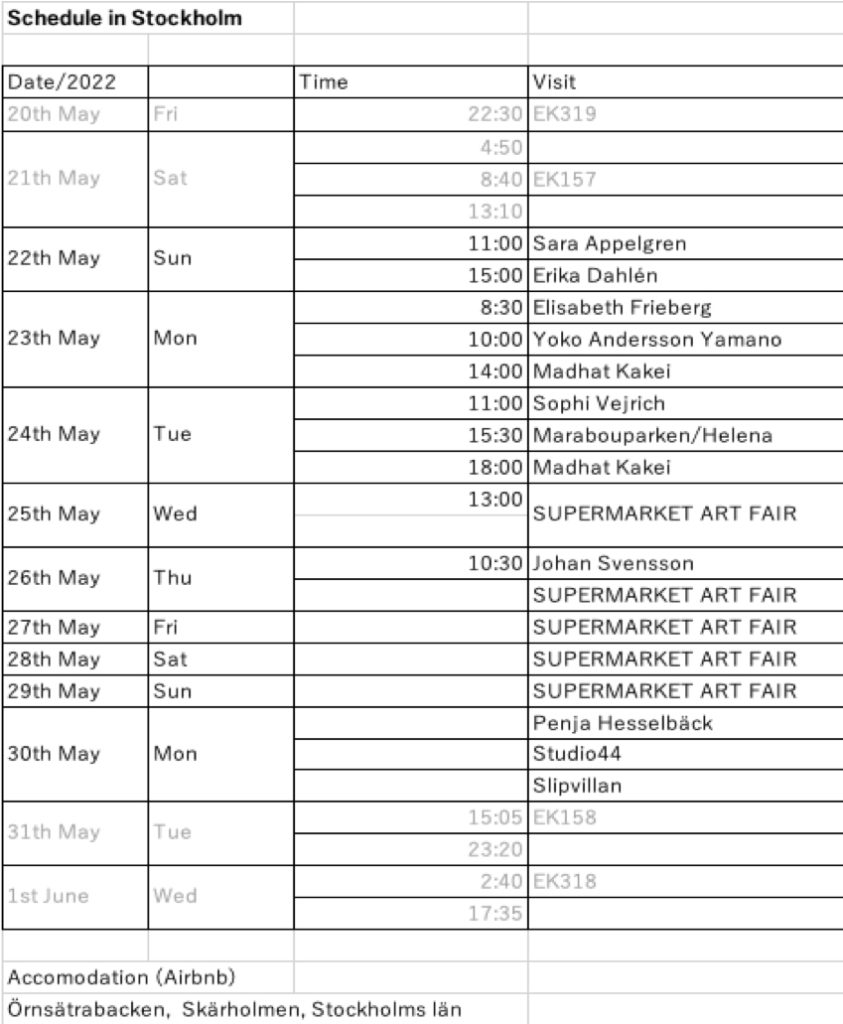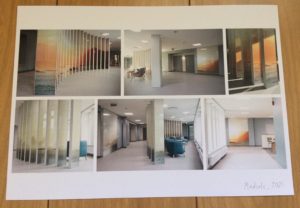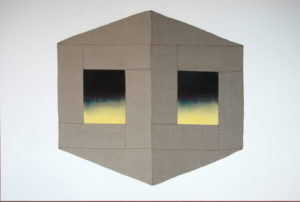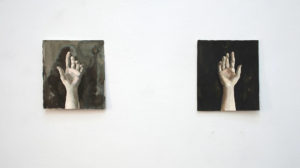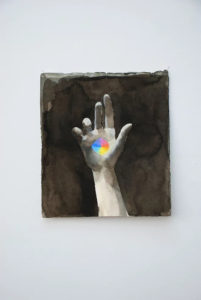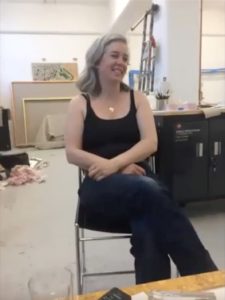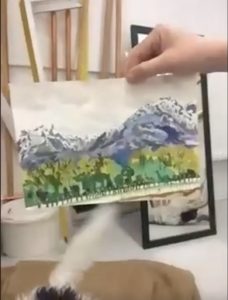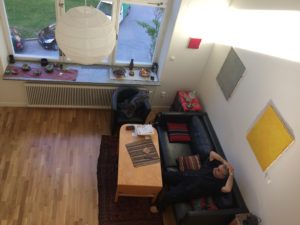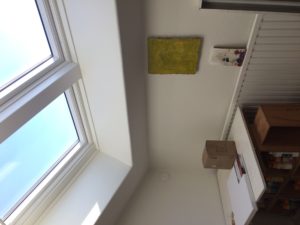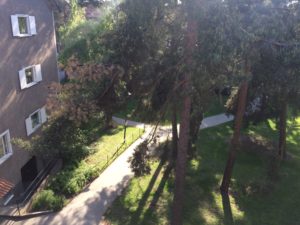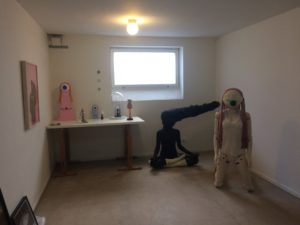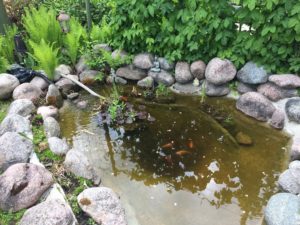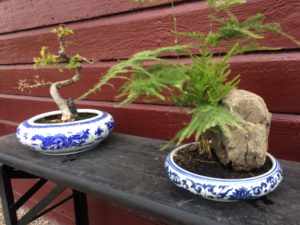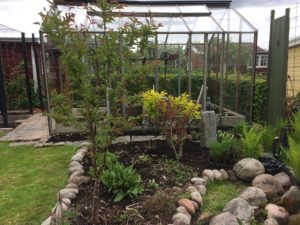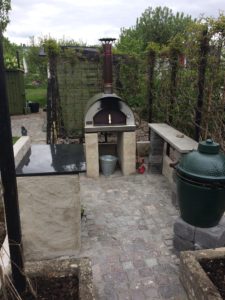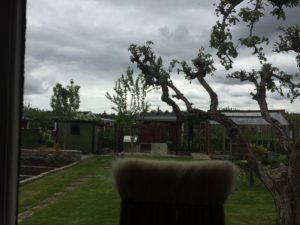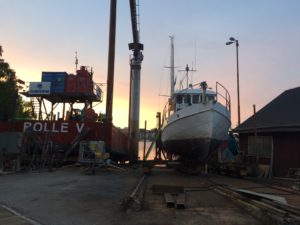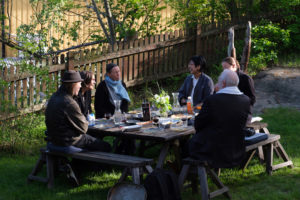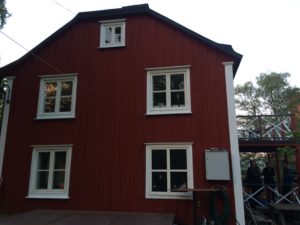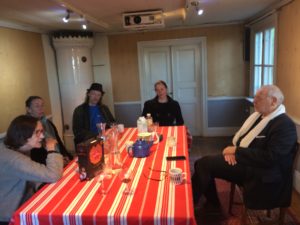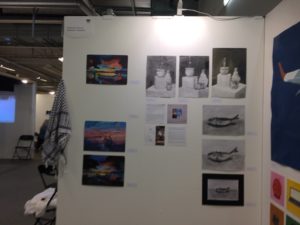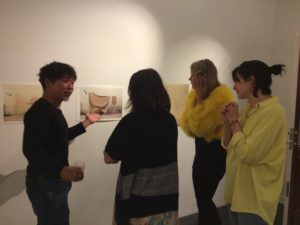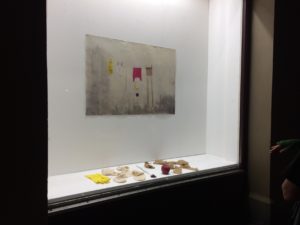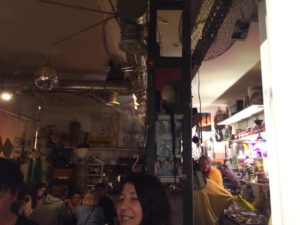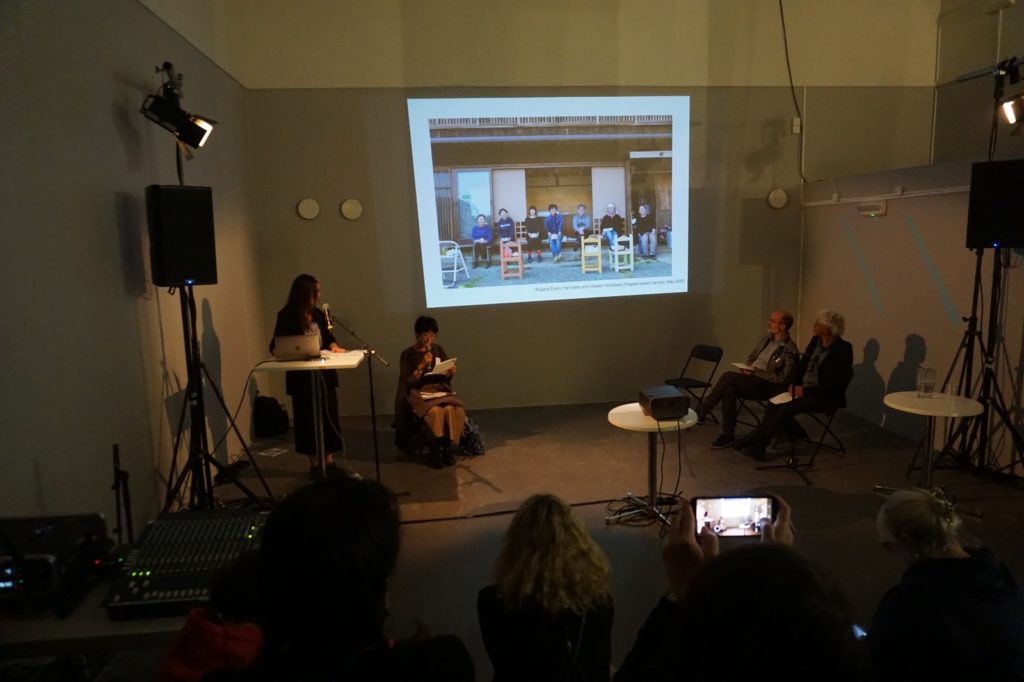Contents
Introduction
Swedish Artist Visit
1.Sara Appelgren
2.Erika Dahlen
3.Elisabeth Frieberg
4.Yamano Andersson Yoko
5.Madhat Kakei
6.Sophi Vejrich
7.Marabouparken Museum/Helena Holmberg
8.Johan Svensson
9.Penja Hesselback
10.Studio44
11.Slipvillan
SUPERMARKET – Stockholm Independent Art Fair
MEETINGS EXPANDED PROGRAMME
25, May / SUPERMARKET FORUM
26, May / Official Opening
27, May / Visit to IASPIS and others
28, May / PUBLIC TALK and Skarholmen – Varberg Walking Tour
29, May / Supermarket Art shots II(Presentation about Niigata Eya Gallery)
Introduction
It all started when Andreas Ribbung, an artist living in Stockholm, unexpectedly came to the NPO Niigata Eya Gallery (hereafter, Niigata Eya). In Stockholm, there is a Kurdish painter, Madhat Kakei, who has held his solo exhibitions at Niigata Eya, and knows Andreas. Madhat recommended that Andreas visit Niigata Eya when he comes to Niigata to attend the opening ceremony of his mother’s, Lisa Larson’s, exhibition held in Niigata city’s Niitsu Museum. Andreas had contacted Okura, the representative of Niigata Eya, via SNS beforehand. However, Okura, who is always very busy, did not notice the message, so it was a great surprise for us. After he visited Niigata Eya, we showed him around the Sakyukan cultural facility which Niigata Eya is involved in managing, and took him to the artist residence “Yui Port” (Niigata City International Art Village and International Youth Center) located nearby. During the short visit, Andreas spoke enthusiastically about the “SUPERMARKET ART FAIR- STOCKHOLM ARTIST-RUN-INITIATIVE” that he is involved in as creative director, and left some materials. After that, he made a persistent invitation to Niigata Eya to participate in the art fair, saying that although he could not raise the funds, he would provide as much support as possible, including information on funding organizations. However, Okura was reluctant at first, but Andreas’ enthusiasm remained unchanged over time, and we began discussing participation in the art fair. With Andreas’ great support, we were able to receive grants from IASPIS in Sweden and the Scandinavian Japan Sasakawa Foundation in Japan, so we decided to go to Sweden and proceeded with our preparations. This was from the end of 2019 to the beginning of 2020. Then the new corona virus began to spread, and the art fair scheduled for April 2020 was temporarily postponed and then cancelled. The art fair rescheduled for the following year, in October 2021, so we were prepared for a postponed trip to Sweden when Swedish entry restrictions were lifted in June of the same year; but about two weeks before the departure date, Sweden resumed entry restrictions. However, we took a gamble and decided to go to Sweden, believing that we were exempt from the restrictions because we were not going to visit Sweden as tourists, but were going to conduct research funded by a public organization (to visit a Swedish artists), and we had been invited to participate in an international event. However, we were crushed at Narita Airport. We were not able to go to Sweden at that time either. But, Masoud Shahsavari of Studio44, an artist-run gallery in Stockholm, whose booth was next to ours at the art fair, printed out photos of paintings by three Niigata-based artists, Hiroshi Kurita, Sinzow, and Momo Hasuike, which were scheduled to be exhibited. The data was printed out and displayed about the creation of the Niigata Eya booth. It was truly an unexpected, fortunate, and happy event to see our booth created by Masoud, which was filled with love and respect for the artwork, the artists, and the activities of Niigata Eya, even though we had never met him before. Despite our not being able to be there, we were able to introduce the three artists’ works to many people who visited Niigata Eya’s booth, even if it was only in photocopies. Our participation in the art fair was serendipitously realized.→instagram
Then came 2022. The main purpose of our original trip to Sweden, to exhibit at the art fair, had unexpectedly been realized the previous year, leaving us the mission to visit Swedish artists, which was the purpose of the grant we had received from IASPIS. Fortunately, the Swedish entry restrictions were once again lifted, and I was able to make my third attempt to go to Sweden at the end of May, just in time for the SUPERMARKET ART FAIR 2022 event. For various reasons, Okura, who was supposed to go with me, could not make it, so Okabe, who was originally his assistant, went in his place and connected Okura with the site via Zoom. Although we were not able to exhibit at the art fair this time, I participated in the “Meetings Expanded Programme,” which was set up for non-exhibiting participants to visit the art fair and Swedish art-related institutions. The 10-day stay was a short but an intense and unforgettable experience. Although the spread of the new virus made my trip to Sweden quite different from our original plan, I would like to thank you, IASPIS and SJSW, and the Swedish artists for providing me with such a precious opportunity, for always being understanding despite the repeated changes in circumstances, and for your warm welcome and hospitality. I would like to express my sincere gratitude to all the Swedish artists and to Masoud Shahsavari of Studio44, who took care of me like a guardian throughout my stay. In particular, last fall, when I was unsure whether or not I would be able to enter the country, I was as devastated as a boxer in a punching bag. I was really, really encouraged and, without exaggeration, heartened by the e-mails I received from Lena Malm from Iaspis and Nikawa from SJSW. I would like to take this opportunity to express my deepest gratitude to them. Thank you so much!
Certified Non-Profit Organization Niigata Eya
Researcher, Azumi Okabe
The artists and galleries visited were selected from the vast number of artist websites provided by Andreas Ribbung, plus a few artists and galleries that I was able to visit on short notice during my stay.
Swedish Artist Visit 1
Sara Appelgren
https://www.saraappelgren.com
“Gentrification” is a word that I have been hearing often lately, and the area where Sara lives is a typical example of it, she told me on her way to her studio from the bus stop not far from the Liljeholmen subway station where she picked me up. Along the way, there is a cement factory plant and other historical buildings that are easily recognizable as having been built for industrial purposes. Artists gather in devastated areas, and through their free, unique and passionate activities, the region was enlivened resulting in the value of the land to rise. The artists are still using the building today, and they are fighting against developers who want to demolish the building and redevelop it, drawing attention to its increased value. It is hard to believe that you can get to the center of Stockholm by subway in short time, but just walking around this calm residential area near the lake is like taking a short trip. Sara’s studio, located in a corner of the area, is on the ground floor of a large house that used to house a grocery store in the 1950s. She did not modify the interior, which retains its original atmosphere, as much as possible, and only installed the walls and shelves necessary for her work. The studio, which she shares with a fellow artist, is a wonderful space that I was completely fascinated by, and it is no wonder that she sometimes comes here even when she is not working on creation. (This place has also changed landlords, and in two years, when the current contract expires, the situation will be different, Sara said.)
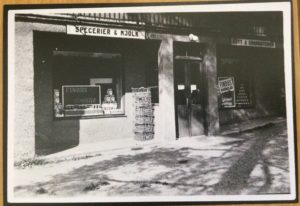
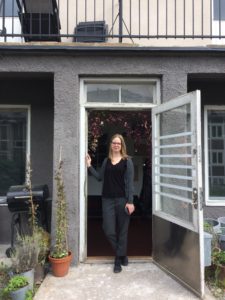
Sara is a visual artist and photographer, but studied sculpture before photography. She has installed photographic works in hospitals and senior citizen facilities in several of the 10 public art projects she has worked on so far. The works were well thought out with regard to the use of the space and its users.
“Medsols”(Clockwise)
A public artwork for a new psychiatric hospital in Skövde, which was commissioned before the outbreak of the new virus and completed over a two-year period in its wake, is a large, photographic installation. It is situated in 4 day rooms on 2 floors of the hospital, outside a large pentagonal hallway, like a round, curved corridor. In Swedish, “Medsols,” the clockwise direction is called “With the Sun,” and as the title suggests, all the works are spectacular landscape photographs, each reflecting the sun at a different height, representing the movement of the sun.
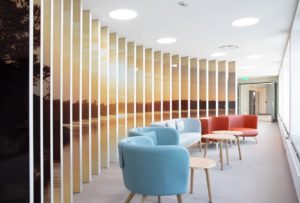
Source;Sara Appelgren’s website
The “1% Rule” is a rule that, when constructing new, renovating, or expanding buildings in Sweden, 1% of the project budget is to be used for public art that everyone can access and appreciate. Sara’s project for a psychiatric hospital is one such example. The application process alone requires a considerable amount of time and effort, but the costs associated with the application process are paid for. In this case, the applicants’ names are anonymous, and the jury will judge the entries based solely on the submitted proposals, without any knowledge of the applicants’ backgrounds. In addition, there were strict rules regarding the materials to be used (e.g., materials/processes must not harm users in case of damage, must be easy to clean on a daily basis, etc.), and the artists had to submit a budget for the entire project from production to installation, including personnel and travel expenses.
As can be seen from the titles of previous works installed in hospitals and nursing homes, such as “So Far, So Close,” “From Here To There,” and “View of a Passing Landscape,” the works are intended to help visitors feel familiarity with the work, to overlay their own memories on it, and to create a spacious landscape in the hospital. The works are like a “door to anywhere” that allows visitors to freely release their spirit into the spacious scenery without leaving the hospital. All of the works were created with careful consideration of the users and attention to detail.
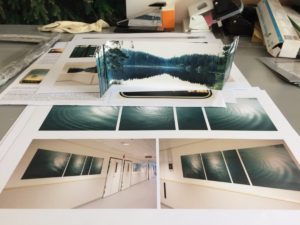
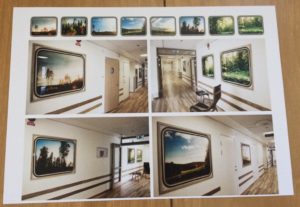
The works created for the exhibition were also very interesting. The work for the group exhibition entitled “Border” was created based on the interpretation of “border” as both a limit and a point of contact where two things meet. Two people embracing tightly are photographed from different angles (from the front of the other person’s face, which the embracing person cannot see) and printed on both sides of a sheet of fabric. The work was exhibited so that the audience could view it in a 360-degree around view.
This work was exhibited under the title “Brace Yourself” in another exhibition on the theme of feminism. From the above series, only photographs of women looking at us were selected and exhibited. The faces were of the women looking at us while being hugged. The backs of the people embracing women are like shields. Is it love or violence, or…? It is very interesting to see how her interpretation of her own work expands.
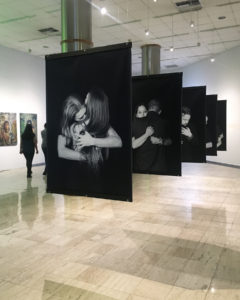
Source;Sara Appelgren’s websit
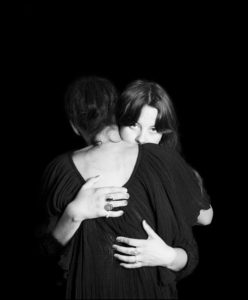
Source;Sara Appelgren’s websit
Other works include a portrait of a performer staring into a mirror in a dressing room before a performance, an audiences staring at the stage, and a gaze turned in the opposite direction by an embrace. The series of photographs focusing on the “gazer” also left a strong impression on me.
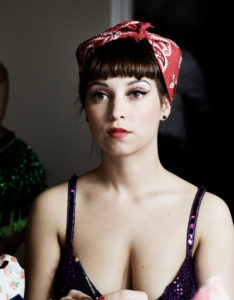
Source;Sara Appelgren’s website
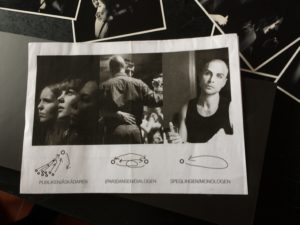
Instead of so-called PowerPoint presentations, she prefers to explain her work by laying out a sheet of paper on a table. She says that this is also how she creates her works: “I like to have a sense of expansiveness in the development of my work if it does not have a clear beginning and end.”
After my visit, Sara took me to Fargfabriken, a former paint factory that is now a cultural activity space with a café and excellent gallery. A lake where people swim at sunset in summer is nearby, and there is also an area that looks like a showcase of buildings with a concentration of symbolic Swedish buildings of different ages, which I would like to call the Swedish Historical Architectural Village. Thanks to Sara’s warm, caring and welcoming concern, the first day of my visit to Swedish artist was a truly happy beginning, as if I had come on a trip abroad and then gone on an excursion.
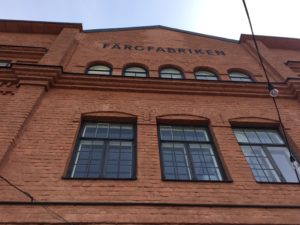
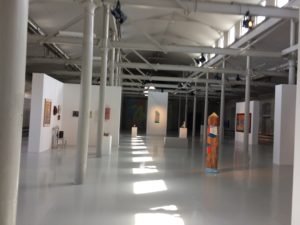
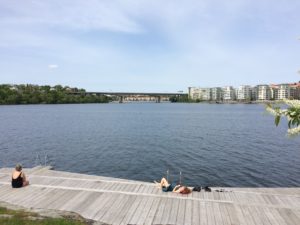
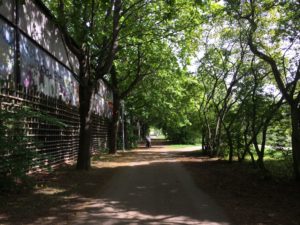
Swedish Artist Visit 2
Erika Dahlen
https://www.erikadahlen.com
Erika’s studio is located on the ground floor of a quiet apartment complex, a five-minute walk from the Axelsberg subway station, which is a few stops away from Sara’s nearest subway station. Passing through the entranceway lined with planters filled with green and flowers, one enters the living room where Erika’s artwork hangs nicely on the wall. When I asked if I could use wi-fi to connect with Okura via Zoom, a tall, beautiful boy came down from the second floor; calling out her son’s name, “I can’t always remember the password,” she said. He quickly entered the password into my i-phone, which must have been difficult to use because of the different alphabetical structure of the keyboard on the screen, and returned to his room.She said he is going to get into a military service officer training course. I was lost for words.
Erika’s paintings are always related to a spatial context. The work itself is a space, an invitation to an adventure within a given framework, a gateway to her own imaginary world, as well as, a view of the outside world, which she is interested in. When you look at a work of art, you move freely between spaces: the physical space where the work is located, the imaginary space in the painting, and the space in our mind where we actually experience the work. She believes that art is a fascinating way to transcend space and time without having to think about it.
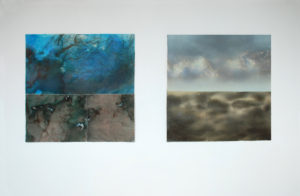
Photo ; Erika Dahlen
She originally studied traditional oil painting and was devoted to having perfect control over everything on the canvas. From there, she began to look for the exact opposite, for coincidences beyond her control, which led her to her current style, using scraps of disused felt and fabrics as materials.
In one series, she first cut scraps of fabric into reasonable sizes, painted or dyed them, and then sewed them together like a patchwork with thread. If the combination was not to her liking, she would try a new one and sew it back together again. She also likes the fact that the dyeing process is like developing a black-and-white photograph: you never know what pattern will appear. The first piece she explained to us was a kaleidoscope of beautiful felt pieces that she created using this technique, pieced together like a patchwork, expressing, according to Erika, her own “yantra” (a symbolic geometric figure used by Hindus as a meditation aid). The works are always depicted with landscapes as motifs. The idea for this unique shape was inspired by the origami shapes that her son, who was interested in origami for a while, learned from YouTube and actually folded.
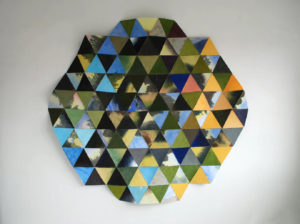
” Yantra I ”
Source;Erika Dahlen’s website
Erika’s interest also lies in the pursuit and examination of “what kind of beings we are” through art. She is fascinated by the human ability to symbolize and find meaning in everything, and has created a series of artworks that serve as a language. The “Hand” series focuses on the beautiful and miraculous existence of hands, which can create objects that serve as keys to the world of the imagination using only their hands and paint.
The “People Carrying Things” series is another work that attempts to understand humans – a living creature aware of its mortality. The world is entering a new phase due to the ecological crisis and climate change, but affluent regions have been completely absorbed by the consumer culture, and their meaning of life lies in buying things, without paying attention to the environment around us and the impact we have on nature. With ecological limits already stretched we are currently in the midst of a profound change in our society and way of life, and it is a painful process. The image of people carrying things in a wilderness-like landscape suggests the world in which we live, but she says that she is also stepping into a more existential level of interpretation: “The deep insight, we can’t stay inside ourselves, is an important starting point for all activities where we reach out to communicate with others.”
The images of mysterious landscapes expressed in many of the works are intended to carry on the tradition of broken scenery. Each work is mysterious and invites the viewer to stand in front of the painting and be led into a world of contemplation. Erika studied abroad in India in the 1980s, creates her works with careful observation and contemplation, and communicates with others through the language of “art.”
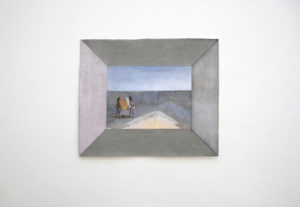
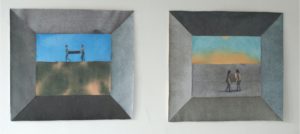
Photos ; Erika Dahlen, “Why are we not in paradise” series
With a nail and a hammer in her hand, Erika showed us many of her past works, repeatedly hanging and removing them from the wall one after another.
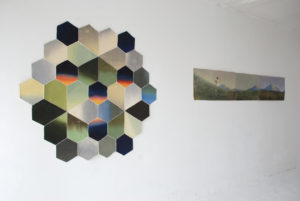
Photo ; Erika Dahlen
After that, I was able to show her the books and files of works by three Niigata-based painters, Hiroshi Kurita, Momo Hasuike, and Sinzow, who were introduced at the Art Fair last year.
She looked at each page with great interest, nodding to Kurita’s work and saying, “Yes, painting is a physical process,” on Hasuiike’s work, “I feel a story,” while with Sinzow’s work, “I feel a sense of comedy and despair. I understand the burden of women raising children in Sweden as well, although not as much as in Japan,” she said. She also told me that in Sweden, many wonderful painters who were not previously taught in school textbooks have been reevaluated in recent years, and that most of them are women artists.
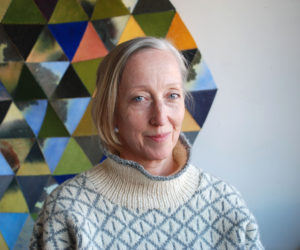
Photo provided by Erika Dahlen
Swedish Artist Visit 3
Elisabeth Frieberg
https://elisabethfrieberg.com
In exchanging e-mails with several artists for scheduling the visit, Elisabeth was the one who always gave me the most concise reply. A few days before the scheduled visit, I received an e-mail asking if she could change the time of my visit. As usual, the brief text included the following: “My husband and I own an island that is a three-hour drive from the studio. We discovered an eagle’s nest on the island a month ago. There are also baby eagles. A specialist is coming to put a ‘ring’ on the eagle (perhaps to observe its conservation). Your visit is important, but I cannot miss this “mega” event. So could you please move up the time of your visit?” The excitement was palpable in the short e-mail, and as I blown away at the content, I became more and more excited about the visit.
I headed for Gustavsberg, a suburb of Stockholm that is a district of large ceramic studios and artist studios and is a tourist attraction; I was greeted with a smile by Elisabeth, who was waiting for me on the side of the road.
The Color Hunter-
Elisabeth’s studio, located in a huge building, is a large rectangular room with pure white walls. The space is large enough to accommodate a large painting. Since I had seen the large paintings that were packed and propped up on the wall in an art book published with a solo exhibition she held in Berlin in the past, I asked her to show me mainly the smaller works that were lined up on her desk and the wall.
The first thing that caught my eye was a handmade various “color chart.” Elisabeth loves mountains and greenery. She first draws a landscape that she likes or has a special feeling for, and then creates a color chart from it. She then paints abstracts using all the colors on the color chart. She paints the landscape of the island she owns with her husband, and the landscape of the Maldives where she traveled to celebrate the 10th anniversary of meeting her husband. She followed in the footsteps of Agnes Martin, a painter she is extremely fascinated by, to Macklin in south-central Canada, the birthplace of Vancouver, where Agnes moved to when she was 7 years old, and to Taos, New Mexico, where Agnes spent a long time after that. She does not like to paint from photographs she has taken; she always sits down on the ground at the location and paints, then she paints using the colors she “hunts” from the landscapes.
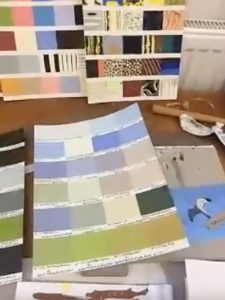
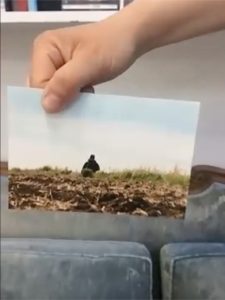
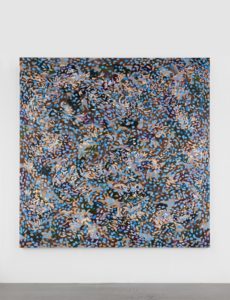
“Taos, Van Gogh, Monet, Natura, No. 3”
Source; Elisabeth Frieberg’s website
She says, “Just as some people receive various emotions from music, I don’t know why, but I can’t help but react to colors.” Without waiting for the words, I think that just by being alive, the vast amount of colors around her constantly speak to her, and that she cannot live without outputting that vast amount of input in some creation or another.
Elisabeth was born into a family of artists: her grandparents were painters and her aunt was a potter. Her own works are abstract paintings, with a particular emphasis on color, and she would rather not reveal the story behind them. However, she introduced to us an exception to this rule: a graphic work she created at the request of a magazine. When she was initially asked to create a graphic work, she wanted to use color, and it occurred to her that it would be a good idea to add color to her grandfather’s monotone graphic work.
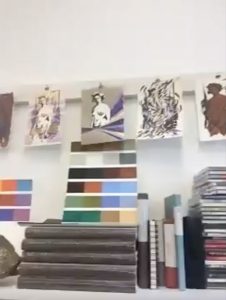
The motif she used was a drawing of his grandfather’s mistress, Inga. For Elisabeth, the process of applying color to the graphic, which was a quickly drawn, thick black outline of her entire body, was a special emotional roller coaster ride that was both revenge and therapy for the mistress depicted in the drawing. “How could my grandfather, who was so kind and wonderful to everyone, fall in love with such a mean woman? Everyone in the family hated this mistress. But in creating the artwork for this project, I wanted to pay respect to my grandfather and make the artwork expressive and beautiful.”
The colors on the copies of the drawings that depicted Inga were all different and beautiful. Elisabeth said that the experience of creating this work helped her to understand her grandfather, Inga, their relationship, and her own feelings.
Elisabeth always tries to entertain herself. She has to have some kind of relationship or attachment with the object of creation. Otherwise, she doesn’t get the energy. If she has a subject that she feels something for, and she wants to paint it, she starts working immediately.
The behind-the-scenes stories of her performances posted on her website were also very interesting, and her stories made me want to listen to her forever. She kept coming up with new works one after another, and I was worried that she might not make it to the “mega event” in time. She took me to Yoko Anderson Yamano’s studio in the same building, and it ended up to pass the baton.
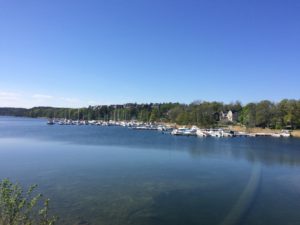
Swedish Artist Visit 4
Yamano Andersson
http://www.yokoyamano.com
When we were corresponding in preparation for our October 2020 visit, Elisabeth introduced us to Yamano, saying, “If you like, I can introduce you to her, whose studio is just around the corner.” I was attracted at first sight by the glass works on her website, and when I contacted her, I was surprised to know that she had held a solo exhibition at “F/style,” a beautiful space that Niigata is proud of, and that she had visited Niigata Eya on that occasion. I had visited her show in Tokyo in January, 2021. This was the first time to see her since then. The glass production studio is on the first floor of the same building. We talked with her in her studio on another floor, looking at her glass works arranged on shelves and tables.
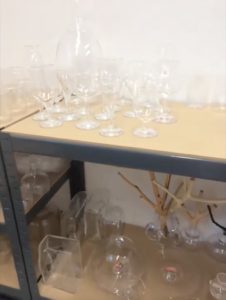
“I want to make pieces that look like the North Korean army.”
Yamano’s stories are interesting in any case. Her point of view is interesting, but her way of expression is also very unique. Soldiers train and train and train to reach a certain proficiency level. The “individuality” of the soldiers marching in unbroken procession inevitably seeps out even when they are trained to the utmost limit. Individuality is revealed while wearing the same clothes and performing the same movements. She believes that her own glass works should have that same degree of individuality.
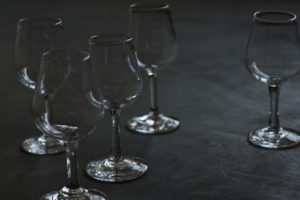
Source;Yoko Andersson Yamano’s website
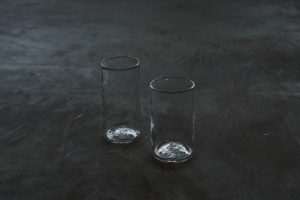
Source;Yoko Andersson Yamano’s website
Listening to Yamano’s attitude toward her work, I felt like I was listening to a farmer. Even in bad weather, they have to accept it and get on with it. Glass is also affected by weather and temperature, and the amount of glass that can be rolled at one time is not perfectly consistent. It is also a job that requires a great deal of concentration, as sweat dripping in front of the hot kiln during production can get into one’s eyes, and a spur-of- the-moment blink of the eye can cause the shape of the piece to collapse.
As a child, when she helped her grandmother take green peas out of their pods, she found it interesting that each bean was different in size. Humans are the same way, and each person’s tiny individuality is very important. If it is a wine glass, the size of the drinker’s hand is different, and the amount of wine drunk is also different. Instead of providing a certain shape that the designer thinks is good, by creating without using a mold she does not have to try to create individuality, but rather allows the individual differences to occur, that naturally appear due to the climate and the amount of glass being rolled. She can make the best use of the materials, and what comes out in the flow of the time is good. In this way, she believes in the existence of someone who thinks this is good, rather than completely judging by herself. She thinks that the way people use glass tableware and their lifestyles differs from person to person.
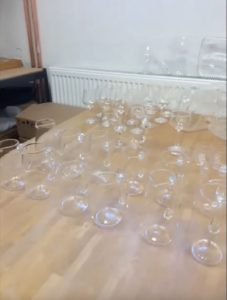
(Below)Recent works collected and exhibited
Only the creator of the work can see it, and it has been interestingly transformed.
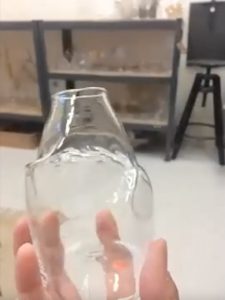
This approach to manufacturing is reflected in Yamano’s ongoing collaborative project: starting around 2018, Yamano has been working with contemporary painters from Sweden, Japan, and Germany to create glassware that they want to draw. The rule is to describe the glassware they want to draw, using only words. Some painters just say “wine glass,” some describe in detail, and others write poetry. Yamano creates the glassware she imagines from those words, but if they don’t like it, the artist can paint it however they like, and the project goes on. It is an interesting collaboration that plays with the differences in the images evoked by the words.
Yamano is curious about the details of people’s behaviors, and often takes notes on what she notices when she finds something new and strange. She is a person who thinks about something in daily life and flexibly builds up her thoughts and ideas as she goes along.
After returning to Japan, I read “Mother to Mother’s round-trip letter” (Shobunsha.Inc), a correspondence with photographer Yurie Nagashima, and I found Yamano’s character is consistent in her writing, as well.
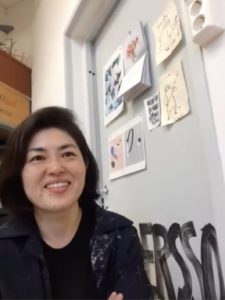
Swedish Artist Visit 5
Madhat Kakei
https://www.madhatkakei.se
Madhat Kakei is an artist who unexpectedly became the key to Niigata Eya’s trip to Stockholm.We had asked Madhat if we could visit his studio before, but unfortunately, he was always abroad and the timing was never right. This time, I was finally able to meet him when he invited me to visit his newly moved into house in Stockholm, where he is currently working on a new work. Although Okura knows him well, this was the first time I had met him.
The studio, located in a corner of a building in the heart of the city where the Lutheran Church and Stockholm Public Library are located, was decorated with Kurdistan carpets and ornaments, and was filled with Madhat’s recent symbolic works, colorful squares of canvas on which identical colors had been placed. I was handed a copy of Arata Isozaki’s report on his visit to Iraq in a magazine, in which the young Madhat was also featured. “I was introduced to a number of prominent Japanese people, including Isozaki, Ichiro Hariu, and Toru Sunouchi. I was really lucky to have met and been introduced to such prominent Japanese people,” he said. At this time, I was inwardly panicking as my eyes kept slipping off the page when I read Isozaki’s precious reportage. On this day, I had forgotten my rental mobile wi-fi, which was a lifesaver during my stay, at the accommodation. Masoud kindly drove me from the studio in Gustavsberg to Madhat’s studio, but I realized that I had left my bag containing important documents in the car. I felt so miserable that my mind was racing with thoughts of how to contact Masoud. Madhat realized I was in trouble and kindly offered to re-arrange the date for visiting, the next evening at his new house/studio. I accepted his generous offer and left his studio. The only good thing was that we were able to connect to Okura via Messenger from the studio where many of his works are displayed.
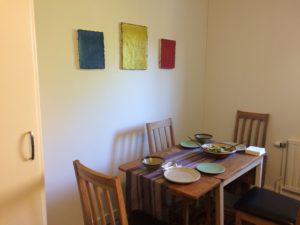
Living as an artist in Sweden-
Madhat’s studio and home, which I visited the next day, was located in a quiet residential area, a
3-minute walk from the Vastertorp subway station.The room, which he had just moved into in February, was enchantingly clean and relaxing.The room has a kitchen, a high-ceilinged living room a large window, a bedroom, and a small loft-like space on the second floor, which he plans to use as a painting room. The simply organized room is decorated with his paintings, stones and colored pieces of wood he picked up, and pottery and ceramics he bought at Mitsukoshi in Japan. He treated me to homemade Kurdish food.
“I am grateful to Sweden,” he said. “I am grateful to Sweden for giving me a house that can shelter me from the wind and rain, and for giving me an environment where I can live as an artist. But even though I have lived here for decades, I have never felt at home. I have experienced many difficulties because I am not Swedish,” he said, his words sounding heavy. After a delicious, spicy meal, I talked about movies with Madhat, who loves movies, and his recommendations, then he showed me a video he had made in the past. It was a documentary that closely follows the later years of the life of his former teacher, who taught him painting for five years in Iraq. Since there were no subtitles, he translated the conversational scenes for me; it seemed that Madhat can’t stop laughing at his mentor’s jokes no matter how many times he watches the same scene, and smiled throughout the film. His teacher, Mohamed Muhraddin, has a Basquiat-like style, and even if you cannot understand his words, you can clearly see his charm from the way he moves on the screen. Since we have many mutual friends and acquaintances, we did not talk much about his work, but talked about the differences between Sweden, France, and Japan, as well as about movies. I showed him the works of three painters in Niigata, and he was fascinated by Hiroshi Kurita’s work, which he said was very Japanese.
(After returning to Japan, it was decided that Madhat’s exhibition would be held in September 2023 at Sakyukan, which is operated by Niigata Eya and Niigata Building Service Co.)
Swedish Artist Visit 6
Sophi Vejrich
http://www.sophivejrich.com
Sophi was most cautious about the new virus during the exchange of visits, as she had been trying to visit the Niigata Eya booth at the 2021 Art Fair, which was made possible by Masoud’s generous support; she was hesitant to go to a large gathering place where people were without a mask and was afraid that she might get sick. After much conflict, she eventually informed us that her son got sick and she had to give up her effort to come. It is the exact opposite of Japan. It is mentally very difficult for one person to live without a mask all the time in Japan. When I thought about this, I could imagine how hard it must have been for Sophi to live in Sweden with the pandemic.
After getting off the subway at Liljeholmen station and walking along the shore of the nearby lake, I came to a quiet residential area where Sophi’s studio is located. Entering the building, one finds a long, narrow back yard and a room about 10 tatami mats in size at the back of the yard. The square room is like a small gallery with Sophi’s past works. Sophi comes from a family of artists, and her sculptor father has a large studio where she creates her work.
Sophi has visited Japan with her husband and son, and has held exhibitions in Tokyo and Kamakura. Her husband died suddenly in an accident a month after returning from Japan, so she told us that she has a special attachment to Japan, where the three of them spent time together.
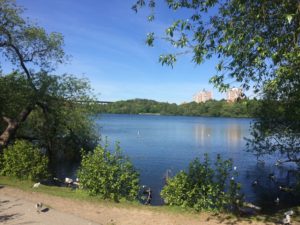
Sophi says that since she was a small child, she has always been a sensitive and imaginative child. When she became aware of the existence of invisible air, she would endlessly wonder for instance what would happen if this air were to disappear, etc. “Air” became Sophi’s longtime theme. The works are not exhibited as stand-alone pieces, but are combined to form a single work of art, with the three-dimensional and mixed media pieces serving as players in the story. The three-dimensional works are sometimes sad, sometimes pop, sometimes cute, sometimes shaped like Japanese yokai (specter), sometimes enigmatic, and sometimes philosophical. They are highly open interpretation by the viewer. The creatures are inspired by Sophi’s life, her emotions, and her surroundings, and they are all born from her richly expanding imagery. One by one, the inhabitants that stir within Sophi are given their own form and appear in this world. The more Sophi lives, the more they appear, one after another.
“Grief” was created in the midst of shock and confusion after the death of her husband one month after returning from her stay in Japan. It consists of a three-dimensional work of a black woman in a yoga pose and two two-dimensional works. The black hairs on her head, which are supposed to be her hair, are blowing out horizontally from the left side to the right side. The legs, sitting cross-legged, are covered with pop white, pink and light blue striped socks. One of the two two-panel works in the set is a photograph of a Japanese stone garden, which means “harmony” to Sophi. The image was taken from the Internet, printed, hand-rubbed, wrinkled, and stretched, then split down the center, separated into two pieces, and placed as before. A line running down the center indicates “before” and “after” the event, expressing memory. The other photograph shows a corner of the sculptor’s father’s old studio; walls, broken glass, accumulated dust and dirt, and a dead insect lying on the floor.
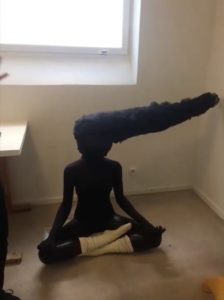
(above)”A Leak on the Underworld”
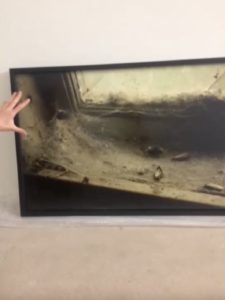
(above)”The Naked Comes with the Net”
Wood, aluminum, bronze, felt, leather, fabric, yarn, dust… Sophi uses and combines an amazing variety of materials. The texture of the materials she uses is also very important to her, and it is surprising that she creates almost everything herself using different materials. She is attracted to primitive objects that are simple but deeply imbued, and sometimes uses Greek mythology and Swedish folklore as motifs.
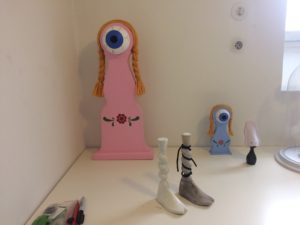
On the other hand, she also likes pop culture and combines these elements in her work. The head, whose brain is very important for human beings, and “hair,” which is closest to the most delicate part of the head, also often appear as motifs. One work, in which annoying “dandruff” is scattered like stars in the hair and on the back, is interesting not only its unique interpretation but also because of the bright pink background and the pop jacked the woman wears.
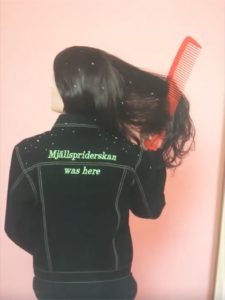
The work, which was born from the strange image of a “vampire drinking her own urine,” is a game of association, with “urine” being the “gold liquid” invented by an alchemist and “beer,” and a green-nosed girl with long pale burgundy braids and a downcast white mask seated on her knees, wearing a meshed running shirt often worn by beer-loving men (or so Sophi thought) combined with a transparent glass filled with a golden liquid.
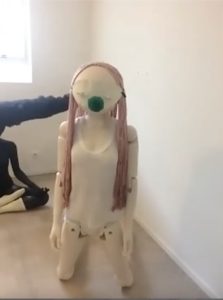
“Wetland, the Gym”
All of the works reflect Sophi’s life, her very personal feelings, events, and surroundings. She says that she wants to be honest and always naked, without mending them. That attitude was conveyed to us through her works on the website and brought us her place.
She gave me a beautiful collection of her past works, with a calm pink binding, saying that you are the first, since she could not give it to Japanese people due to the pandemic, although it included a Japanese translation done by a Japanese poet. I feel very honored.
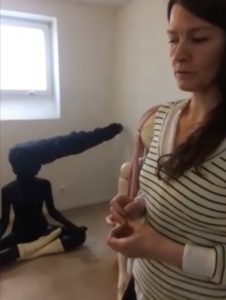
Swedish Artist Visit 7
Maruborou Museum/Helena Holmberg
https://marabouparken.se
After Sophi’s visit I walked a few minutes to take the tram from Grondal, and got off at Ballsta bro. From that stop, I walked straight down the wide street and Marabouparken Konsthall (hereafter referred to as Marabouparken Museum) appeared on my left. It was a beautiful sunny day, and the adjacent large park was filled with families and adults lying around in swimsuits enjoying the sun, just like at the beach. As one approaches the museum, a number of magnificent sculptures appear. While I was waiting for my appointment, I took pictures, one by one.
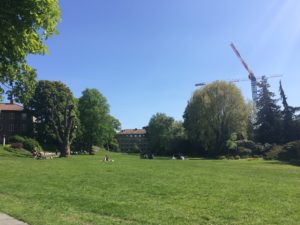
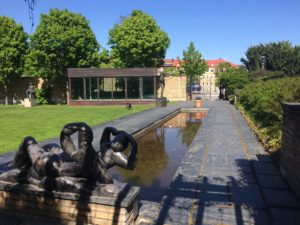
The Marabouparken Museum of Art was established 15 years ago by Marabouparken, a Swedish chocolate company (currently an international company), which donated its historic factory and adjacent park facilities to Sundbyberg, the smallest city in Sweden. The city of Sundbyberg has promised to use these facilities for cultural purposes, and the sculptures scattered throughout the park were mostly donated to the city. The museum is about 80% subsidized by the government and the city of Sundbyberg and their region. The building used as an art museum used to be a laboratory of a chocolate factory, and it now houses a gallery shop and a restaurant. Helena Holmberg, a museum officer, guided me through the museum in a smooth and orderly manner within the limited time available. At this time, the exhibition was not one of the exhibitions held three times a year (spring, summer, and winter), but the annual bachelor exhibition of the Royal Academy of Fine Arts.
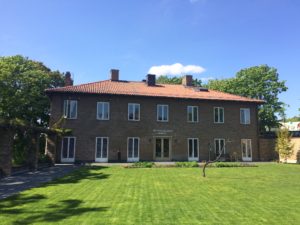
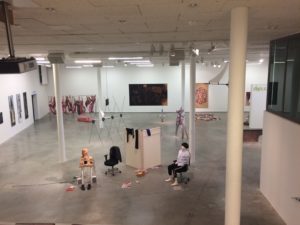
Four hundred people gathered here for the opening party, which was said to be a lively mood. The works of the 20 students, including students from Syria, Denmark, and other countries, were displayed. Helena’s impression was while in the past there were more conceptual works, in recent years there has been a trend toward textiles and handmade crafts. There were paintings, sculptures, videos, and some of their works were displayed inside elevators, or in the corner of a conference room, where one of the student exhibitors from the academy collected dead flies to create his works. Admission to this exhibition is free, but general exhibitions organized by the museum cost about 10 Euros to enter. The themes of the exhibitions are defined as those that tie in with the adjacent park, and focus on the relationship between nature and humans in a state of global warming and other environmental issues we are facing.
The conditions for the grant from the public institution receiving support are that the cultural facility must be accessible to all. It required to consider accessibility for people who have handicaps, any gender, any age, but there is no request for the content of exhibition. The museum is operated by a small staff of 4.5 people, one of whom is in charge of the education department. They frequently invite outside artists to give workshops for children. The workshop room, named “Monster Room,” was a cute and exciting space with colorful flags waving in the air, and in the corner of the classroom is a “wooden sculpture” that the children made inspired by an artist’s work. It was quite a work of art.
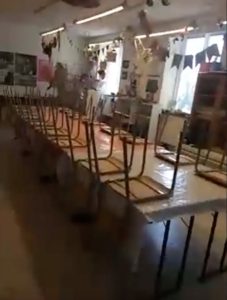
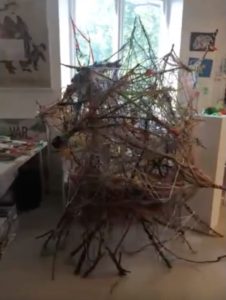
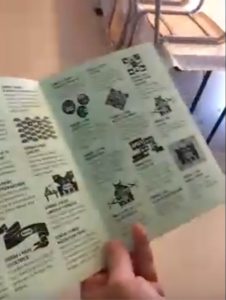
The museum receives about 10,000 visitors a year, and although it would be desirable for the government to increase the number of visitors, it is necessary to plan exhibitions and events of high quality in order to receive national government subsidies, so they are focusing solely on quality rather than quantity. What is an obstacle is that the budgets available for marketing and public relations are very small, and because of that even with high-quality exhibitions, it is difficult to compete with large museums. It is a common issue throughout the world.
The image everyone has of Sweden as a “welfare state” was fostered during the upsurge of the workers’ movement, the free church movement, and the temperance movement. Public education that emerged in the last century, and the participants in these movements were enthusiastic about educating the public. Since culture played a major role in these movements, the idea that culture should be accessible to everyone and serve as a tool for building a better life is deeply rooted in Sweden. Helena thinks this is Sweden’s historical legacy.
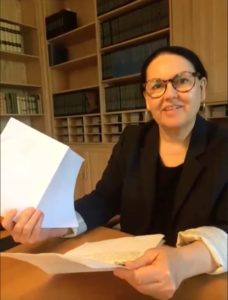
As an example, she introduced a public art project that she had undertaken yesterday. The name of the project is “Kitchen Square.” A typical Swedish kitchen made of concrete is located in a square on the outskirts of the city, where creative activities are held for children, and adults cook and enjoy their meals in the “outdoor kitchen,” a three-dimensional work of art. Urban planning researchers, politicians, artists, and local residents participated, and a conference was held at the museum during the event to exchange ideas. Sweden has a large immigrant population. The women who live in the same community gather to play with their children, cook together, get to know each other, share knowledge and wisdom, and exchange opinions on issues in their lives; many social concerns come from them.
Kitchen Square is an art project that has a substantial function in society, and the Marabouparken Art Museum is involved in many of its activities. This perception of Swedish culture has both positive and negative aspects. The negative aspect is that museums tend to take responsibility for problems that should normally be solved politically. Nevertheless, Helena said that compared to other countries, Sweden’s cultural policy is more generous, which is fortunate for those who manage museums.
Swedish Artist Visit 8
Johan Svensson
http://www.johansvensson.org
A short walk from the Slussen subway station, where stores line the main street in the center of Stockholm, leads to a forest park with shining greenery, and through it to a quiet residential area. Johan’s studio is located on the first floor (sort of a half-basement) of a corner lined with large buildings of similar appearances. He had just installed a public artwork in a kindergarten in Uppsala, and although the studio was empty, he said he could show me his work on his computer.
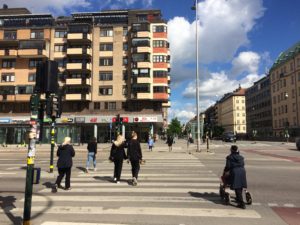

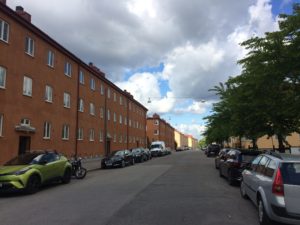
Johan is from a small farming village in southern Sweden. His mother wanted to be an artist, and there were beautiful paintings by her hanging in the house. His mother, who had not been able to fulfill her dream due to marrying early and having children, never pressured him to do the same. And eventually he took a path that his mother couldn’t take. He spent his college years in the South and then moved to Finland with his wife, an architect/artist. He is currently based in Stockholm. He says that he was able to come here because of the support of IASPIS, and I learned once again the importance of IASPIS.
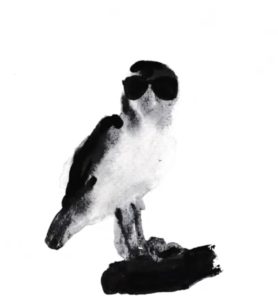
“A creature that sometimes floats around, dipping its body into a dark place in the mind”
We wanted to visit Johan because we were attracted by the striking drawing of a crow wearing sunglasses on the top page of his website. It was a drawing created for an exhibition titled “NIGHT TIMES.”
Johan is a doodler. He creates a lot of drawings and paintings in a short period of time. He draws repeatedly and watches them develop.
Sometimes it develops in an interesting way, often not. Sometimes there is a theme, but it is the same, not knowing what will emerge or how it will turn out. He usually does not critique any of the drawings that appear, and only looks back when he chooses a work for an exhibition.

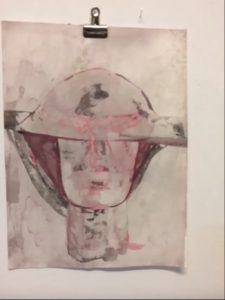
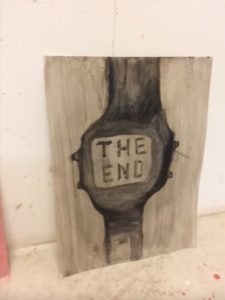
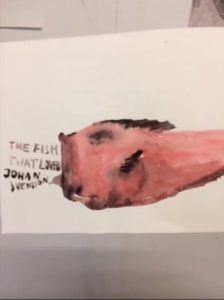
Sometimes spontaneous drawings give birth to animations. In a recent work, “Grass,” the grass is growing and swaying in the wind. Then, a big tire comes along and mows it down. This video was shown by repeatedly projecting a transparent film onto the roots of a large tree that was placed in a lying position in the installation. Arranged around the tree were three-dimensional mice, like a live-action version of the world of a picture book.
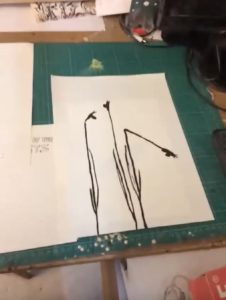
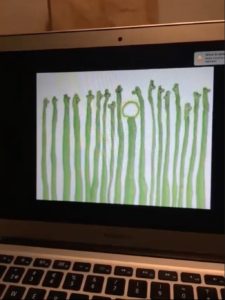
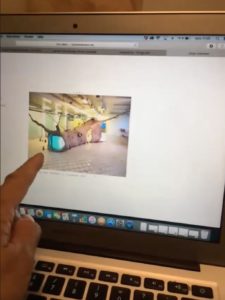
Johan’s work, which seems to be well-liked by children, has been installed as public art in three kindergartens. There is a giant three-dimensional sculpture of skewered wild strawberries in syrup (a Swedish sweet), and a work in which the part covering the light of a street lamp is a knit hat or cap. Four spheres, each with an expression representing four different emotions; surprise, anger, pleasure and sorrow – were installed at different heights and in different colors.
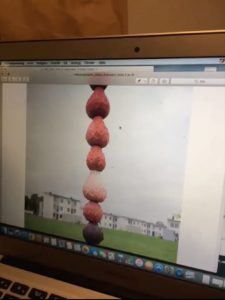
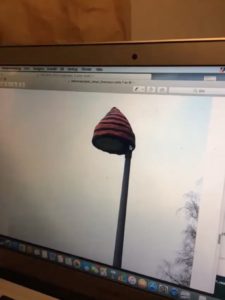
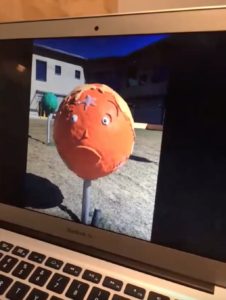
On the other hand, the first public artwork he worked on was for a hospice where people with little time left to live spend their final days in peace and quiet, and he created three “bridges” connecting this world and the next. Three “bridges” were created to connect the afterlife and the real world: a standing bridge with a beautiful structure, a bridge with a house as seen in Thailand, and a suspension bridge inspired by an old movie. The artist took care not to make the bridges too severe for the viewers.
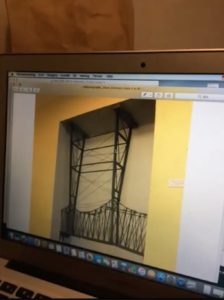
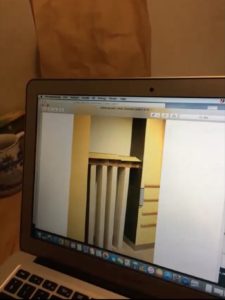
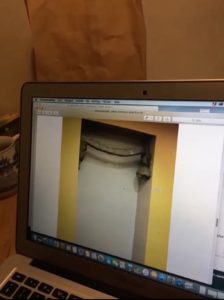
Okura’s impression of Johan is that he is like a creature that sometimes floats around, dipping its body into a dark place in the mind, and he is absolutely right. Johan is tall, quiet, and reserved, but in a dark place inside his mind; there is a boy named Johan who has been drawing pictures for a long time, looking at things with a bit of a wry, slightly nihilistic attitude. He is peering at us from behind Johan’s eyes. That’s how I felt. He and his work have a mysterious charm that attracts people.
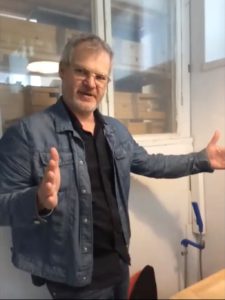
Swedish Artist Visit 9
Penja Hesselback
https://www.penja.eu/whyitakepictures
On the day before returning to Japan, Masoud, who had been busy every day, offered to accompany me for the day, so I decided to accept his hospitality fully. In the morning, I was picked up from my accommodation and taken to the PCR center in the Centrum at the Fittja metro station to undergo the necessary inspection for entry into Japan. After that, I revisited Sara’s studio in Grondal. I received a file of the works she had prepared for me during my stay, and then headed up to Uppsala. After passing through the city of Stockholm, I was greeted by a vast plain. There were no hills in the distance, just a horizontal expanse of farmland. With the Hidaka Mountains in the distance and windbreaks woods separating the large fields, the landscape is familiar to Tokachi, Hokkaido, where I am from. In any case, the scenery is unlike that of Stockholm, and then a town appears.
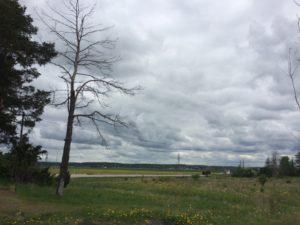

Perhaps it was because I had heard that it was a university town, I could not help but notice the young students. As we proceeded down a quiet street that looked like a suburban residential area, we came upon a huge citizen’s garden that looked like something out of a movie. It is the Tunakolonin Citizen’s Garden. It is a garden version of Japan’s so-called “citizen’s farms,” and there are cottages in every plot. The houses, called summer houses, have fireplaces and kitchens, but no bathrooms or showers, which are provided in a separate communal clubhouse. It is said that it is not easy to get a plot of land in this area, and all the tenants are trying their best to create their ideal garden.
One of the people who has this “dream garden” is photographer Penja, who is also a member of Studio44. Masoud had remembered how interested I was in Penja’s work after seeing it on Instagram, when she was participating in a photography group exhibition curated by Masoud.

Penja’s husband, Andre, welcomed us at the entrance of the garden and gave us a brief explanation of this citizen’s garden. (I found out later that each plot is a little over 400 square meters). After walking along the paths of the garden, which were arranged in a grid pattern that was impossible to reach on my own, Penja was standing in front of the garden waiting for us.
Andre showed me around the garden. Andre has a deep knowledge of Chinese and Vietnamese culture. There is a Japanese-style garden with a pond for carp, a greenhouse for growing vegetables, and an oven for baking pizza. There is also an Italian- style garden corner. The garden, which has been gradually taking shape over the years, is called “Beiban Yuan.” It was named after the garden of the same name in Suzhou, China. I was breathtakingly amazed at its originality, aesthetic creation and perfection.
When we visited the summer house, a light brick-colored one-story house, the interior was white, and the sofas, tables, and bookshelves were tastefully arranged, making it look like a vacation home. “We love it here and spend a lot of time here,” Penja says.
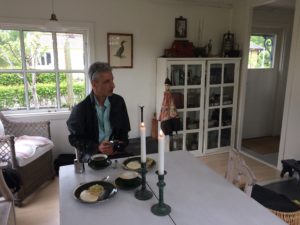
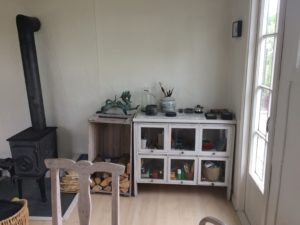
Penja’s father was also a painter. She studied painting partly because of his influence, but found it too time-consuming for her. She began to feel the gap between her senses and the speed of conversion, and switched her paintbrush to a camera. She lived in Kenya for a while as a travel photographer. People, people, people. After returning to Sweden, she began to seek landscapes where there were no signs of people. This led her to her current style and theme. While listening to her stories, she invited us to visit her studio for a short time if I wanted, and we drove to Penja’s studio in Masoud’s car. We visited her in a room in a residential area about five minutes from the garden. The walls of the large, rectangular space and well-organized studio are lined with Penja’s large photographs.
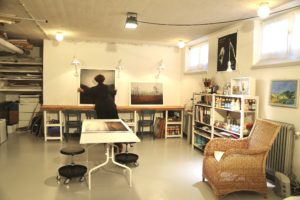
Photo provided by Penja Hesselback
They are all serene and stunningly beautiful landscapes that seems to exist dynamically and quietly, with no sign of people and no one to know about their changes in the passing days. It is tempting to simply surrender oneself to the scenery in the photographs.

Source;Penja Hesselback’s website
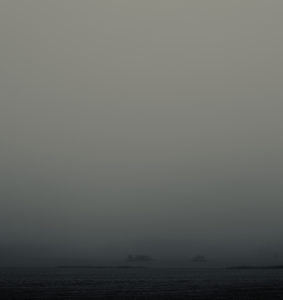
Source;Penja Hesselback’s website
The photographs were taken with a digital camera and printed by a longtime friend. When I heard that she stands next to her friend and instructs him on colors when printing, I realized that Penja’s camera is indeed a paintbrush
There was a unique pause in our conversation, and the beauty and strength of the way she stared at me deeply remained with me.
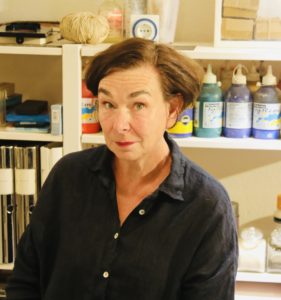
Source;Penja Hesselback’s website
Swedish Artist Visit 10
Studio44
https://studio44-stockholm.com
Last fall, when we had to turn around at Narita Airport due to having been completely defeated by sudden re-entry restrictions, Andreas suggested as a “second best” that we send high-resolution photo data of the works to be exhibited, print them out locally and, with the help of art fair local participants, set up a booth at Niigata Eya. We were pleased with their willingness to proceed in the direction of somehow making it happen, and asked if they would do so. I was immediately introduced to the three members of Studio44, Masoud Shahsavari , Ekaterina Sisfontes , and Rikard Fåhraeus . Masoud played a main role in the project. He created a wonderful booth within a limited time frame, and when I expressed our gratitude to him, he said, “We created this together,” which choked me up. Then I learned that Mizue Ogiso, who had had an exhibition at Niigata Eya, and her partner Mitsuhiro Ikeda, both had held group and solo exhibitions at Studio44 when they were living in Sweden. When I was surprised and immediately told Masoud, Janneike Brantas , who was sitting right next to him at the time, exclaimed, “They are my friends!” Visiting Swedish artists and participating in art fairs are both important purposes, but personally, the most important task of my visit to Sweden this time was to meet Masoud and express our gratitude to him in person.
Studio44 is located on the second floor of Kapsylen, a huge historic brick building at Tjärhovsgatan 44, Södermalm, in the heart of Stockholm, where many galleries are located. Formerly a factory producing cans and bottle lids, etc., the building was purchased by the Kapsylen Economic Association in 1978 and houses 16 cultural organizations, including a recording studio and a cafe.
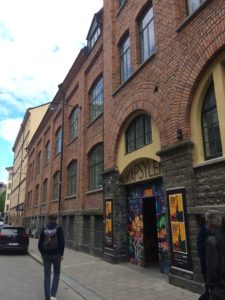
Studio44, which currently has about 30 artists, is an artist-run gallery established in 2003 as a place for artists to freely create and exhibit their work, as opposed to a commercial gallery. In addition to presenting their own work, the artists who belong to Studio44 are also in charge of curation, inviting artists from abroad to collaborations and holding group exhibitions, and sometimes the members hold exhibitions in other artists’ spaces as exchange programs. During the exhibition period, the program also includes screenings, guest lectures, workshops, poetry, music, and other events. The organization Studio44 consists of a board of directors and working groups, and all members are part of a working group and all work is carried out on a non-profit basis at present. The organization has received support from the City of Stockholm, the Swedish Arts Council, The Swedish Arts Grants Committee, and Nordic Culture Contact. While all the galleries in Stockholm were closed due to the pandemic, Studio44 was the only one that was open as usual.
It was a closed day, but Masound showed me around. After walking up the stairs and opening the door, I was surprised at the size of the space spread out in front of me. To the left of the entrance is a bar space and an office, and there are two exhibition spaces in the front and a large room in the back.
The ceiling is very high and the windows are very large. Just by sitting in this space, you can relax and stretch your body and mind. At the time of my visit, the two rooms in the front of the gallery were being rented out to non-members for exhibitions, and in the large room in the back, Inger Bergström, a member of the Kapsylens, which shares the space with Studio44, was working on her next exhibition. A large piece of fabric in progress hung on the wall, with a large window in the background, she was working with a sewing machine.
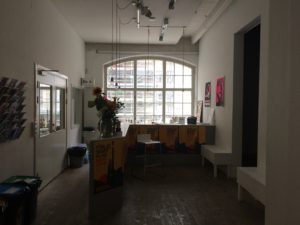
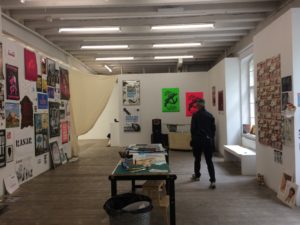
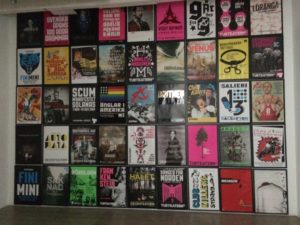
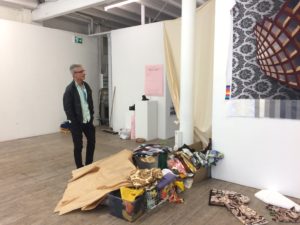
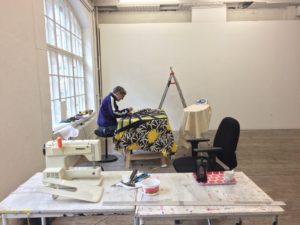
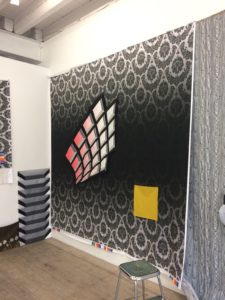
The “Creative castle” that Linda Nykopp, the founder of Studio44, has been pursuing is “a platform where artists can hold exhibitions independently and freely, a place where they can inspire each other with their free ideas and expressions”. The “Creative castle” celebrates its 20th anniversary next year.
Swedish Artist Visit 11
Slipvillan
https://slipvillan.org
After Studio44, Masoud took me to Slipvillan in Langholmen. It is a reddish-brown cottage near the waterfront and right next to the shipyard. In the shining green garden, tables and chairs were set up, where sat Studio44 members Jannike, Rikard, and Laetitia Deschamps, as well as Hans Overvliet and Willy van Houtum from ruimteCAESUUR, who carefully looked at the files of the three Niigata Eya artists at the art fair. I was thrilled to be in their company under the blue sky over takeout Indian food and wine, and to be able to spend such a relaxing time on my last day in Stockholm!
We went inside the cottage because the wind was getting cold, and found a kitchen, a toilet, and a large dining room with a fireplace on the first floor. I wondered what kind of place this was while I was immersing myself into the cozy, joyful evening.
Then, just a few days later, I realized that this was the venue for “The Uninitiated,” a group exhibition in which everyone who was there would participate. I learned that it was not just a nice cottage, but a magnificent cultural facility with studios for local artists and artist-in- residence from abroad on the second floor, and that it was co-operated by Studio44. Until the final moment of the trip, I was blown away by the number, venue and activity of artist-run spaces in Stockholm.

Reference / SUPERMARKET MEETINGS EXPANDED PROGRAMME PDF
Day 1
(25th May / SUPERMARKET FORUM)
SUPERMARKET – Stockholm Independent Art Fair (hereinafter referred to as the art fair) is an international art fair for people involved in independent activities run by artists, regardless of the form of gallery, etc., and has been held annually in Stockholm since 2007 as a counterweight to commercial art fairs. The fair, which changes venues each year, offers a variety of programs for networking among participants, including performances, discussions, and forums, in addition to booth exhibits by participants from various countries. The three creative directors of the art fair, Andreas Ribbung , Alice Máselníková , and Pontus Raud , are all artists, and each of them organizes the art fair while working as an artist.
The 15th art fair in 2022 was held in the basement of Skärholmsplan 1, a large commercial complex with a coop near the Skärholmen subway station in the suburbs of Stockholm. 63 artists, curators, and other organizations from 26 countries participated by having exhibition booths. Since Niigata Eya did not have a booth this year, we had hoped to just see the exhibition hall, but Andreas recommended that we participate in the “Meetings Expanded Programme” (hereinafter referred to as “Expanded Program”), a special program for non- exhibiting participants, and we decided to attend.
On May 25, the first day of the unofficial art fair (the day before the official opening), I went to the reception desk and was given a name plate with a picture of an octopus on it and was told, “Yes, you are the octopus group.” Since the fair was to be opened to the media and VIPs that evening, all the booths were already completed, and participants were already “socializing” here and there with drinks in hand, creating a sense of excitement that the fair had begun in the venue. I am not very good at such social gatherings by nature, and before that, I had never been in a place where so many people gathered at once for more than two years, so I was confused as if I was on a different planet when I saw them all smiling at each other without wearing masks.
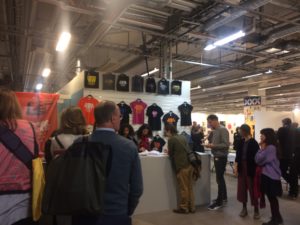
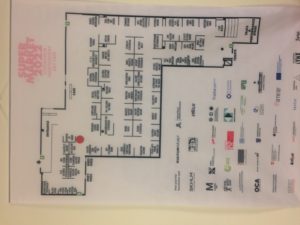
To calm myself down, I connected with Okura via Zoom and gave a tour by walking around the energetic venue, and while I was relieved to talk to him in my native language, from this point on, I was stunned by the true purpose of this fair and the program designed to achieve it. By the way, even though the fair has been held many times, I was still impressed at how well the volunteer staff moved around the fair. They were truly professional. I noticed that there were two rows of chairs lined up near the entrance of the venue, facing each other in a “knee-to-knee” proximity, and an announcement was made for everyone to sit down. Everyone sat down as instructed, not knowing what was going to happen, and naturally exchanged greetings with the people across from them. After five minutes, an announcement is made and the person in the row across from you moves to the seat on your right, and you greet the person who has shifted to your left. This is repeated every five minutes and continues for more than 30 minutes. At first, everyone was a bit surprised, but it was the best way to “get to know” each other. Since the venue was so crowded, we had to get closer and progressively louder to communicate with the other person, even though we were knee-deep in the crowd to begin with. Since you can’t talk to people if you are worried about infection, I thought this was an event that infection-sensitive people could not attend in the first place. 5 minutes is a very short time, so most conversations end halfway through, but once you exchange a few words, it gives people a chance to visit your booth and make it easier to talk to you. When the event was over and everyone was thirsty, we took a break, and chairs arranged in a straight line were brought to various places in the venue, placed around round tables, that were found here and there in the venue.
We were then divided into groups, and I went to the table of the octopus people, which consisted of about 12 people; Alice hosted a discussion on the theme, “How do you handle criticism and self-reflect on your work as an artist (or curator)? “ This kind of discussion is a program designed by Alice and her colleagues to help participants not only in establishing a network through participation in art fairs, but also to take away something that will be of practical use to them in their own activities and operations in the future. Anyuta Wiazemsky Snauwaert of Between Us, Belgium, introduced “DARS ART,” a method for constructive criticism that is not personal attacks, and everyone took notes. After the discussion, a tour of the octopus group members’ booths was organized, one by one, including those of Redaktion (Switzerland), Galleri LOKOMOTIV (Sweden), Konsthall Kaddis(Sweden), Between Us (Belgium), and Visual Art Forum (Palestine).
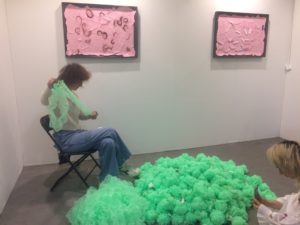
Between Us(Belgium)is an activity started by Anyuta and her partner Kim Snauwaert, two people of the same gender who are legally married. However, it was not born out of romanticism, but a marriage “for sustainable social life” that Kim proposed to Anyuta, a Russian citizen, to overcome the situation that she wanted to stay in Belgium, where she was studying, but could not. It is not a so-called love marriage, and it
is not the married life that many people imagine, but there is trust, respect, and humor between the two of them. “Between Us” is a project about social involvement based on generosity, responsibility, and empathy as expressed through their relationship.
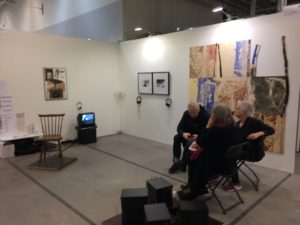
Galleri LOKOMOTIV(Sweden)is a gallery in Ornskoldsvik, 700 km north of Stockholm, run by the non-profit organization OKKV (Ornskodsvik Collective Artists’ Workshop.) The booth exhibited works by Maria Sundstrom and two other artists. Maria, who has German roots and majored in journalism, explained a long-term archiving project she has been working on with her friend Elisabet Blomberg. After World War II, Maria’s grandfather, a member of Nazi Germany,emigrated to Sweden.
After the war’s end, many soldiers like her grandfather emigrated from Germany to Sweden. Maria’s grandfather died when she was five years old, so she has little memory of him. Elisabet, on the other hand, has Jewish roots. The two have been interviewing and documenting German and Jewish war survivors and their families living in Sweden. Maria’s work on display was an installation using sound sources from that archive, photographs of her grandfather, and other materials, an approach that transformed private memories into universal.
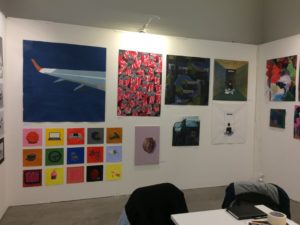
Visual Arts Forum(Palestine) has been operated by the Palestinian NPO Art and Culture Organization since 2002. Its five main activities are The Visual Art School, an unconventional school where people aged 5 to 70 gather to engage in cultural activities, psychological/social support, community awareness, youth support, and advocacy/lobbying. Some come to the art school as a hobby, others to become professionals. The goal is to raise awareness of culture and identity in Palestinian society, to cultivate art as a basic tool of expression and creativity, and to develop free thought. The booth was lined with paintings, mostly by children, and one of the students told me that the children who could not come to the site were very excited to see their work being shown to the world.
After that, simultaneous performances began at the official performance space and other booths here and there, making it seem like a “school festival” for adults. The socializing, aided by alcohol, continued until late at night.
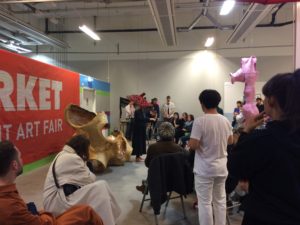
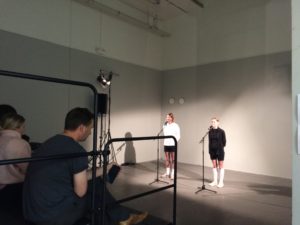
SUPERMARKET – Stockholm Independent Art Fair
Day 2
(official opening day/ 26th May)
After Johan’s visit in the morning, I had bibimbap for lunch at a Japanese restaurant run by a Chinese near the art fair venue. I was so engrossed in showing the art fair to the Niigata Eya members via Zoom that I realized that the Art Shots and other presentation programs I was supposed to attend had already finished, and I hurried to the performance venue. I missed the presentations by Altan Klamovka Gallery from the Czech Republic and Garage33.Gallegy- Shelter from the Ukraine. I was told by “Expanded Program” coordinator Lucie Gottlieb that she wondered what happened to me because she couldn’t see me, and I hung my head in shame. The program was a presentation of “Future has Desires,” a project led by Secil Yaylalı , an artist living in Italy, and Zeynep Okyay , a curator living in Istanbul.
The spread of the new virus has forced us to change our way of life by requiring “stay-homes,” but it is also an opportunity to reflect on our past lives and values, and to think about the future. The same is true for the activities of the artist collective. “Future has Desires” will take the changes brought about by the pandemic as an opportunity to survey those involved in the actual operation of the collective about their current activities, discuss the results, publish them, and think about the future.
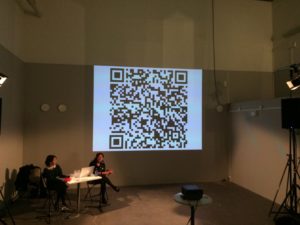
The results will be used as a basis for discussion and consideration of the future. Currently, artist collectives tend to operate individually and compete with each other rather than cooperate with each other. By exploring the awareness of the participants and connecting their activities, the project will consider a feasible future vision. The survey was focused on neighboring countries with similar geographical, social, and political conditions to those in Turkey. Experts in sociology, philosophy, and psychology also participated in the survey, and asked questions with both positive and negative nuances. In order to collect more candid responses, the survey was conducted without names, and the questionnaire was sent to several artists belonging to the same organization. What was interesting about the results was that the attitudes and ideas of the participants differed more than expected, even though they were working for the same collective.
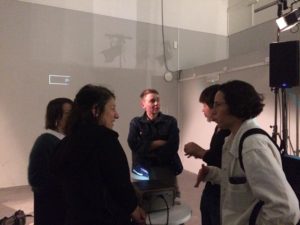
After the session, there was a discussion about whether artist collectives should be managed by a leader with centripetal power, like a hierarchy, or whether they should be run on an equal footing.
The two Turkish ladies who participated in the Expanded Program were kind, generous, and gentle, always inviting me to lunch/dinner and showing me around the Gamla stan of the old town on the last day of the Art Fair, saying, “You haven’t seen it yet, have you?” I can’t tell you how reassuring that was. I am truly grateful.
Performances were held throughout the evening at performance venues and booths, including the booth of Candy Land, a Stockholm-based, artist-run gallery to which Andreas belongs, and where Japanese artist “Daisuke Takeya ‘s works were on display. He gave a performance at the booth every night. Using a chest of drawers borrowed from a second-hand store in the shopping complex where the art fair was held as a prop, Takeya’s performances, which involved flour and coal, were audience-participation oriented and attracted a great deal of attention. Takeya is currently based in Ishinomaki, Iwate prefecture, Japan, but has spent much time in Canada and has participated in art fairs and residencies around the world. When Andreas saw Takeya’s performance in Romania, he was so impressed that he approached him, which led to this exhibition.
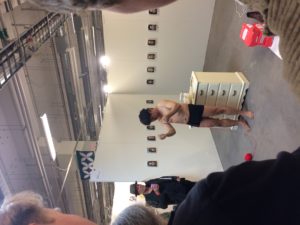
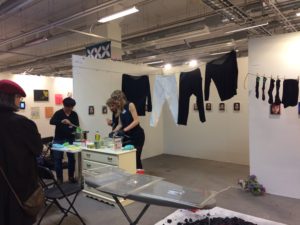
I was going to leave quietly that day, but I ran into Agness Cemme of Ag Gallery in Latvia, Volkan Kiziltunc of NOKS Art SPACE in Turkey, Christoph Draeger of Konsthall Kaddis in Sweden, and others at the exit. We decided to go to a bar at a hotel near the venue. They were all quite tired, and we ended up having a casual chat, but Christoph told me that he was making a documentary about Japan in 1995, the 50th anniversary of the atomic bombings of Hiroshima and Nagasaki, the Great Hanshin-Awaji Earthquake, and the Sarin gas attack on the subway; also that the title of the documentary was “Un Ga Nai- Bad luck,” and that I had not even seen it. I felt creepy. The film is available on vimeo (I watched it after returning to Japan, but the title just didn’t make sense to me). I thought that I would never be able to get together with these members for a drink again, and I thought that this kind of once-in-a-lifetime occurrence was one of the best parts of the art fair.
SUPERMARKET – Stockholm Independent Art Fair
Day 3
(27th May)
IASPIS
The meeting place for the day-long “Expanded Program” was Iaspis, which funded Niigata Eya this time. As Masoud said, “Stockholm is in chaos,” there are construction projects everywhere in the city, and
even though I checked the roads on Google Maps, there were many cases where I couldn’t pass through due to construction. The official name of Iaspis is “the Swedish Arts Grants Committee’s international Programme for Visual and Applied Arts,” and it is a cultural support organization directly affiliated with the Swedish government. It is located on the third floor of a large building, and Lena Malm, with whom I have been in contact for a long time, invited me in and showed me around.
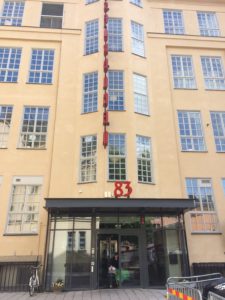
I was first stunned by the size and style of the space. It made me speechless. In front of a private room where a male executive-like staff member worked, because he handled confidential information, there was a heavy white mesh door that could only be entered with a key. The lounge with kitchen looked like a café, and there were nine artist residency studios on the floor. Accommodations were available nearby, but Giuditta Vendrane, an Italian artist in residence, said, “It’s really great, but it’s a little too luxurious.”
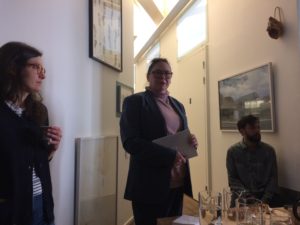

The program is open to artists based in Sweden, regardless of nationality, but there are also several branches outside of the country, and the support provided is substantial. However, I was told that the competition is high, and in many cases, after years of applying, they finally win a grant. Listening to Lena’s lucid explanation, everyone in the room let out a sigh at the generosity of support.
As Helena from the Marabouparken Museum explained, just by looking at the Iaspis facility, one can understand the importance Sweden attaches to culture as a nation and its attitude of utilizing art as a tool for international exchange. Iaspis supports not only for the SUPERMARKET ART FAIR, but also for commercial art fairs held simultaneously in Stockholm.
After leaving Iaspis and walking through the shopping district, which would have been crowded with tourists if the pandemic hadn’t occurred, a seemingly historic building appeared. It was Konstnarshuset (Art House), the oldest gallery in Sweden. Owned by The Swedish Artists Association, it has been used as a gallery since the end of the 19th century. Before the exhibition, I was first fascinated by the building. After taking the small, dated and entertaining elevator up to the first floor, visitors enter the gallery space through a doorway, where a variety of three-dimensional works were displayed in a spacious manner. (The gallery space consisted of this large room and a smaller room on the floor above it.)
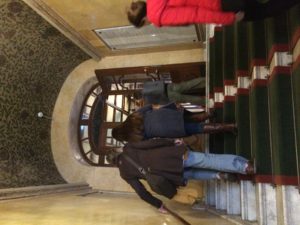
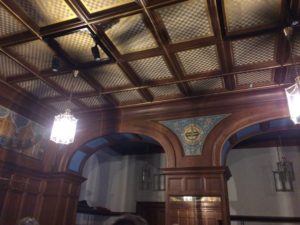
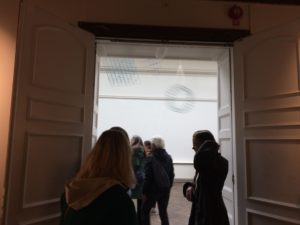
At the time of the visit, a group exhibition titled “Portionsavund” was being held by Maria Toll, Hans Åkerlund, Ida Persson, Petter Rhodiner, and Gunnel Boman. Alida Ivanov, who curated the exhibition, gave us an explanation of the works, but I couldn’t hear her well because the venue was too large. I think she was saying that she was happy to be able to introduce veteran artists born in the 30s and 50s who have experienced the Swedish art movement and their work. Unusually, this gallery only had flyers in Swedish (their website is also only in Swedish), which made me feel closer to them as if I were in Japan.
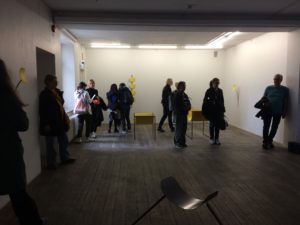
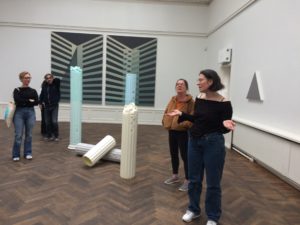
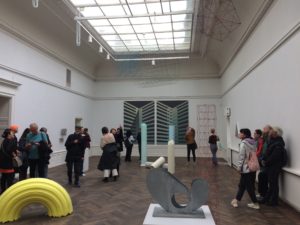
If it were in Tokyo, this is a place like Otemachi or Marunouchi. Misschiefs Takeover is a glass- walled gallery that stands out from the crowd of businessmen in suits. The gallery is run by Paola Bjaringer, who is full of confidence and energy. The 500 square meter space on the ground floor of a prestigious building used to be the largest laundry factory in Stockholm. The glass-walled space facing the main street is the gallery and the back is a studio where eight female artists are working. Showing the process of creation is also a pillar of their activities. After seeing Iaspis, I am no longer surprised to hear that this spacious space is rent-free with the support of a Swedish real estate company.
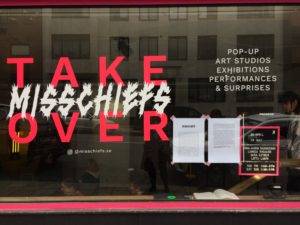
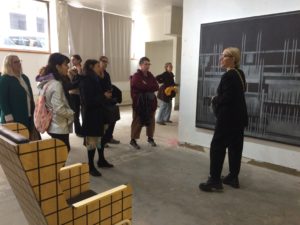
It all started when Paola, a French former gallerist, moved to Stockholm and felt that the Swedish art world was male-dominated and that there were no female or non-binary artists she wanted to meet. So, in order to meet people, she walked around Sweden to look for the artists she wanted and literally “met” womxn designers, artists, and curators, both famous and unknown, one after another, and organized exhibitions and studio residencies. The network of womxn artists from all over Sweden and abroad ranges in age from 28 to 87 years old. The choice to do this work in a former laundry factory where many women used to work is fatefully coincidental. It gives womxn who live in places that are difficult to be seen by society a place to play an active role. The first step is to present them by creating a place for womxn artists. Misschiefs Takeover is a punk feminist movement to change society through art.
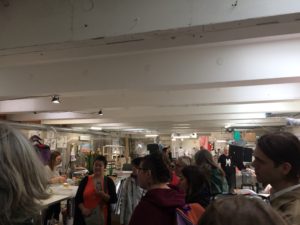
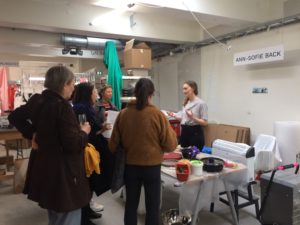
At this time, a group exhibition of four artists and designers, Sara Szyber, Lotta Lampa, Anna-Karin Rasmusson, and Linnea Rygaard, is underway, and their punk, pop, and energetic works, Paola’s belives, seemed to be conveyed through their works. As the name suggests, this is a “takeover” space, so she plans to move to a different location in the future and to develop her activities abroad.
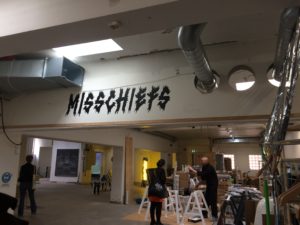
In a flash of inspiration, I asked Hanna Stansvik, a painter who was working in her studio, to take a look at Sinzow’s work files. I was very happy that she looked at Sinzow’s work so intently, even if it was only for a short time.Lucie, the coordinator of the “Expanded Program,” who also has French roots, told me that it is incredible that Paola had done a wonderful job of building a network of contacts, gaining trust, and bringing her work to this level in only six years since moving to Sweden.
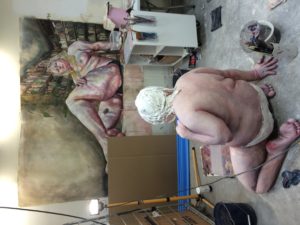
Hanna Stansvik’s work
About a third of the participants left for a late lunch, and the rest of the group went to the last stop, Index, the name of the gallery space, which is officially called The Swedish Contemporary Art Foundation. This has been in existence for more than 40 years and has a special place in the Swedish art scene. Marti Manen, the current director of the Foundation, gave us a tour of the gallery, and like an endless stream of water from a fountain, he quickly conveyed a great deal of information.
Hanna Stansvik’s work
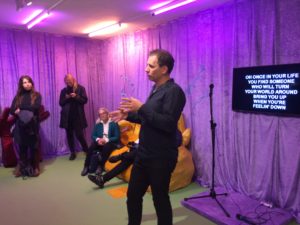
At the time of its founding, the organization’s activities were focused on photography and publishing, but gradually shifted to contemporary art. The organization was divided accordingly. The organization is proud to be known not only in Sweden, but in Europe as well. The gallery has also become a place for artists to present their work for their debut, with many older artists who have held solo exhibitions in the past telling younger artists about their experiences and the social background at the time.
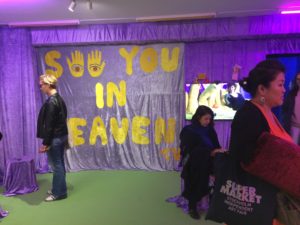

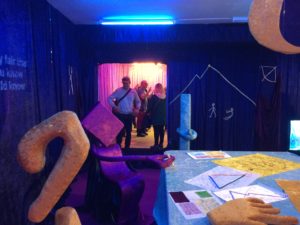
The exhibition underway was “TRAGEDY (I can’t live if living is without you)” by Linnea Hansander, a young Swedish artist. The large space was divided into three zones, all covered with velvet drapes, as if we were on the stage of a theater. The theme of “tragedy” is presented with large, colorful puppets and hit songs from the past, creating a space that makes you laugh and think about human life at the same time.
The mission of Index is to be “a platform for artists and a platform for audiences,” and the role of an art institution such as Index is not to begin and end with an exhibition, but to create a relationship between artists and audiences through activities, research processes, and learning programs. Index is another place that embodies the Swedish attitude toward culture.
After our last visit, Secil asked Lucie for information on recommended restaurants in the area, and with an overly hungry and empty head, I followed Secil on foot. We were joined on the way by Zeynep and Maja Gade and Arngrimur Borgborsson, artists from Gelleri CC in Malmö who were exhibiting at the art fair, and we all went to an Indian-style restaurant in Sodelmalm. From the restaurant, we found that Candyland, which was also exhibiting at the art fair, was nearby, so we all walked to the gallery.
Founded in 2004, Candyland is located in one of the most gallery-concentrated areas of Stockholm and is currently run by nine artists. It is a small white cube space with exhibition area in the show window, and there is a small bar at the back of the gallery. On this day, Andreas and Takeya were there for the opening of an exhibition of photographs by Italian artist Sandra Lazzarini. Although Sweden is known for its unique response to the spread of the new coronavirus, Andreas told us that there was still a lockdown period and then they had displayed art pieces in the gallery’s show window.
SUPERMARKET – Stockholm Independent Art Fair
Day 4
(28th May)
The day’s “Expanded Program” consisted of presentations and site visits, beginning with a presentation at the performance venue.
Ehermeral Care
Ehermeral Care is a research group of multinational artists investigating the ethics, activities, and structures of artist-run initiatives, and this presentation was about their work. The presenter was Joe Rowley, who has roots in England and Sweden. Unfortunately, I could not understand almost anything that Joe explained, partly because my brain was frozen due to the large amount of information input from the daily visits and exchanges.
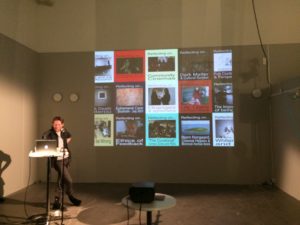
My English is partly to blame, but I think it is almost impossible for a person from a region where you have never studied abroad and do not speak English on a daily basis to understand the intricacies of a native speaker’s rapid speech. This means that those who can participate in the “Expanded Program” and understand the entire program, as well as the art fair itself, are either from English-speaking countries or those who are based in other countries but have a high level of English ability and knowledge; Japan (at least as far as I know), is very limited in this respect. The art fair itself, although it bears the title “International,” is basically dominated by Scandinavian and Eastern European artists, with the Middle East (Palestine) and the U.S. added to that, and there are no participants from Asia, South America, or Africa (some in the past, but very few). Japan is one of the countries that are fortunate to have a grant organization such as the Scandinavia Japan Sasakawa Foundation, which has allowed me, as a representative of Niigata Eya, to be in Stockholm; but I realized that only a very limited number of such people are able to gather here. It was also disconcerting that every booth was interesting and there was nothing that I could not understand at all; and I realized that what is called art in Japan was introduced from the West and created in a Western format, that the leading edge is always considered to be the West, and that I am living under the very influence of this. There are many great artists in Niigata, but not many of them can communicate fluently in English like the artists exhibiting at this art fair. I don’t think that Japanese artists need to be like this, but it is an indescribable feeling to see the participants deepening exchanges and opening up new possibilities at the art fair venue. When I mentioned the language barrier, Zeynep said, “It’s the same in Turkey,” which made me think not only about language but also about what the international situation is and what the art world is like.
Also, almost all of the participants had a surprisingly good image of Japan, and they all said that Japan was one of the countries they would like to visit. Even the artists who had been to Japan before wanted to go back if they could. When asked why they were interested in Japan, many of them mentioned Japanese architecture, stone gardens, Zen, and Butoh dance. When I think about the fact that most of these things are not close to me in my westernized life, I can’t help but think about the “longing that has crossed over these countries” and also about my current living environment and its history. I am still in the process of thinking of it.
After this, there was another short tour of the art venue, this time to see the booth of Ormston House in Ireland, and next to visit a gallery near the venue.
We had been blessed with fine weather throughout our stay, but it was raining on this day. The site is within walking distance from the art venue, but to avoid the rain, we took the subway for one stop and walked along the roads and forests of the suburbs until we suddenly came upon a huge old building.
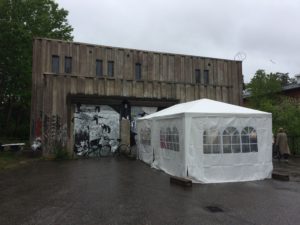
Kummelholmen is a large structure that was originally used as a boiler facility. The owner approached the designer to see if the building could be used as an art facility after it had been unused and damaged for some time after its industrial role. After two years of removing the large amount of items left inside, cleaning, and renovating the facility, the use of the building as an art space began in 2015. Torbjorn Johansson, co-owner of the facility and an artist, showed us around. On this day, a group exhibition of art school students was being held, and in any case, flat and three-dimensional works were displayed in the expansive space.
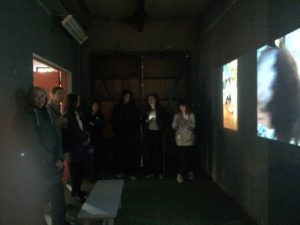
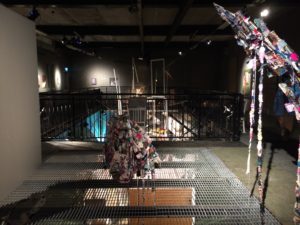
There are few art spaces in Stockholm that utilize buildings like this one, and the power of the space is so strong that it seems to stimulate the creativity of the artists. In Niigata, too, there are buildings that were built for industrial purposes and are no longer in use, but if they are privately owned and located on industrial sites; they are not seen by the general public, and only when they are torn down we realized their existence, as we experienced last year. Older facilities are difficult to use because they do not meet current standards for earthquake and fire resistance, and they are expensive to renovate and to maintain. The joy of being there, even without the exhibited works, was so strong that it left a deep impression on my body.It was also a fortunate example of a facility that has completed its original role.
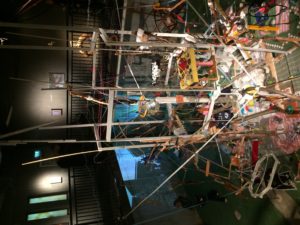
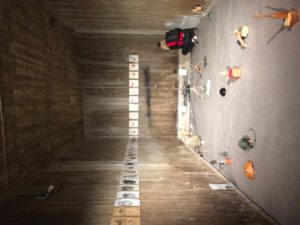
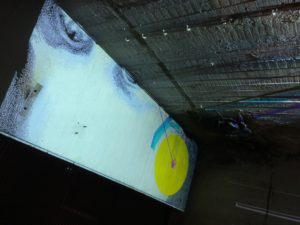
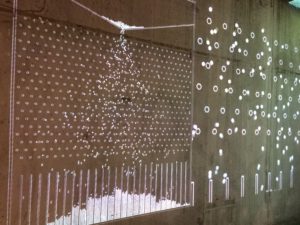
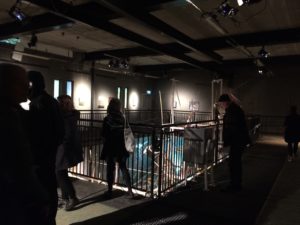
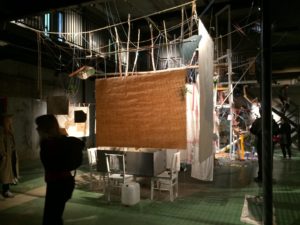

The next stop was the exhibition space Atelje SKHLM, located in a shopping complex that houses a surprisingly large art fair venue, but I was too hungry to continue and went to have a late lunch with Secil and Zeynep, before going back to the art venue to attend an evening therapy session, “Therapy session with a drink”.
The “Therapy session with a drink” is a program facilitated by Alice, one of the creative directors, in which we discuss the art industry and what we feel about working in it in a relaxed group therapy setting over beer or wine. The rule is to listen to the end without interrupting. First, each person says a few words about his or her frustrations. Starting with “I don’t have enough money,” “I’m tired,” and “My parents don’t understand what I’m doing.” Some of the participants also lamented that art fairs are held “only in English,” and that “the Swedish art world has a lack of critique. There was also a discussion about gender, age, and nationality, and while there was some discomfort about being asked about these issues when exhibiting or applying for grants, there was also talk about the current situation in which people are able to receive grants and participate in programs based on these “categories.” It was also a valuable opportunity to hear the voices of the Expanded Program participants, who were otherwise too busy with visits and presentations.
SUPERMARKET – Stockholm Independent Art Fair
Day 5
(29th May)
The final day of the Art Fair begins with Art shots2 at the performance venue. Presenters were Niigata Eya, Ausstellungsraum EULENGASSE from Frankfurt, and basement from Austria.
Two presenters from Ausstellungsraum EULENGASSE were artist Vládmir Combre de Sena and architect/designer Harald Etzemüller. Vládmir, who moved to Frankfurt from Brazil, greeted them during his visit and said, “Ah! Niigata Eya! You are going to make a presentation before us. I’m not good at English, so I’m a little nervous.” I’m not the only one! I was suddenly reassured. In addition to the “Expanded Program,” the Art Fair also features various talk programs and live performances, including an interesting session on “gentrification” on the 27th, facilitated by an Iaspis officer. Although there were supposed to be many present, I got the impression that booth exhibitors were having a hard time attending those activities, even with announcements, as many of them were unable to leave their booths unless they had more than one participant; and many of them valued communication with attendees and audiences at their booths. On this day, too, the audience was mostly “Expanded Program” participants, and to relieve my nerves, Secil and Zeynep started to yell “Niigata Eya–! Yeaaaaaaah!”, and I was very grateful to be able to give my presentation in an at-home atmosphere. The two presenters from Frankfurt, like me, worked hard to read out their manuscripts and I could feel the empathy of the coordinator, Lucie. The Austrian basement had a presenter who was infected with corona, so Lucie presented on his behalf.
“Art Shots,” which introduced each activity, was presented in a “pecha-kucha” style, in which 10 images were presented in less than one minute each. No questions were raised on this day, perhaps because the presentation ended with a brief overview of each activity. In particular, Niigata Eya is a gallery run by “viewers” rather than an artist-run gallery, and I explained that the historical background of the introduction of the term “art” was a translation of the word “Bijutsu.” However, I also thought that they might not have known what questions to ask because of the very different backgrounds. (Niigata Eya’s presentation is following)
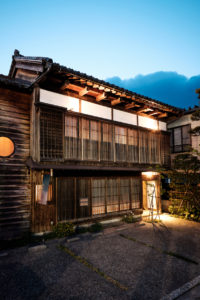
1 Niigata Eya Gallery’s building
Niigata Eya Gallery is not an artist-run gallery, it is a viewer-oriented gallery.
Niigata city is located in the northeastern part of Honshu Island, Japan, lying along with the Sea of Japan.As you see, the gallery’s building is a traditional Japanese style house, but the interior had been renovated in the western style. We restored the interior back to its original design. Our intent was to have a place to exhibit paintings and various other genres of art expressions, as well as, to offer them for sale, in this traditional Japanese style setting.
“Eya” means a shop that sells paintings in old Japanese language. Niigata Eya Gallery was established in 2000 by 9 members.
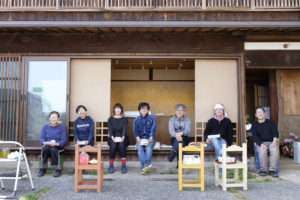
2 Niigata Eya’s members and Hisako Horikawa(Niigata-based dancer)
The members consist of a carpenter, a furniture craftsman, a Haiku poet, a graphic designer, a photographer, an art critic, and others in various fields; every single member takes charge of managing the activities, not as an artist, but as an individual viewer.
At monthly meetings, we introduce artists respectively, that we think are good, and curate exhibitions.
We have held more than 600 exhibitions with over 300 artists over 22 years.
The standard of curation is to present the art works that a Niigata Eya member appreciated and desired to feature as an individual viewer.
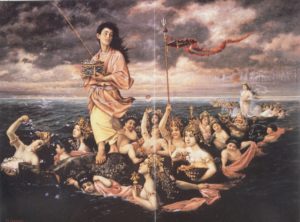
3 An Oil painting in the Meiji(1868-1912)Era_ “Urashima_zu” by Hosui Yamamoto(1895)
Art or plastic art in the Japanese language is “Bijutsu.” “Bi” means “beauty,” and “Jutsu” means “way”, ”method,” or “meaning.” Japan’s Meiji Era ran from 1868 to 1912, and “Bijutsu” was created by translation in its early years.
This new word, “Bijutsu,” produced the new social system, such as in art schools, museums and exhibitions.
This change occurred first in Tokyo, the capital city of Japan; thus, Tokyo is considered the source of everything new as it is the mega introduction place of Western culture.
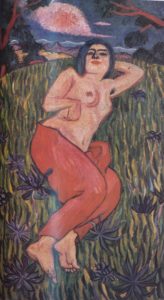
4 A Painting in the Taisyo (1912-26)Era_”Nude Beauty” by Tetsugoro Yorozu(1912)
Soon after the word “Bijutsu” was coined, the drastically changing era, the 20th century started, and revolutionary art works showed up one after another; they appeared in Tokyo rapidly. Especially Van Gogh was introduced to art-lover youths by a literature group named the “Sirakaba group;” this dramatically spread the concept that Bijutsu to not only mean the creation of beauty but also it is about self-expression.
This thought had a huge impact on art expression in Japanese people and it extended the range of “beauty;” but also it confused viewers who look for “beauty” in art pieces.
As a result, it was believed that “only art specialists could appreciate and understand the art.” This mind- set prevailed among ordinary people.
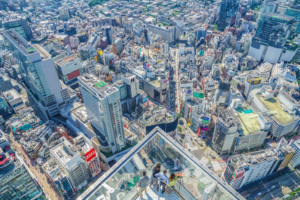
5 Tokyo scenery
Then, people aiming toward art expression went to Tokyo, created in Tokyo, and exhibited in Tokyo.
In the late Maiji era, the exhibitions started to be presented by the national government, which was mimicking the Salon in France.
Private competitions also began, and these became a hierarchical system.
Climbing up the pyramid of hierarchy became equivalent to gaining social prestige.
In this era, the people left behind the most were the viewers who appreciate the arts but lived in other areas than Tokyo.
They judged art expressions under the mind-set of following what others said. Appreciating art meant going to the museum to see so-called famous artists’ works. This practice became the norm.
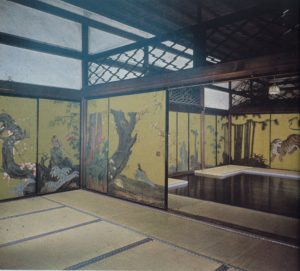
6 Interior of an old temple
Before the word, “Bijutsu”, paintings, sculptures and crafts existed close to Japanese people’s daily lives.
For instance, there might have been a rich person’s house, that had a place called “Tokonoma,” where art pieces were displayed and viewed.
Painted Fusuma and painted Shoji functioned as partitioning walls defining rooms and spaces within a building.
However, westernizing house styles removed Tokonoma, and got rid of paintings from doors. Paintings that were once intimately entwined with daily lives became special entities, cut-off from our lives, and were only being appreciated through the cognitive bias of the hierarchy system on unusual occasions at an exhibition venue.
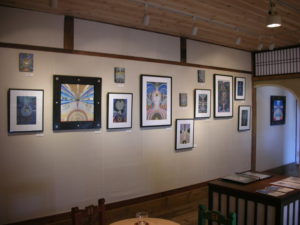
7 Exhibition scenery in Niigata Eya _ Antje E. Gummels’s exhibition
Despite Japanese people starting to live in the western style rooms having many walls, Japanese didn’t hang any paintings on those walls.
Niigata Eya Gallery was born in Niigata city, which is one of the cities in this situation.
We turned Niigata Eya’s space that had been renovated in the western style back to the original interior.
This way of creating the space had meaning.
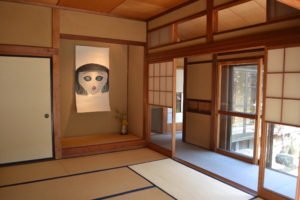
8 “Chieko”by Sinzow hung on Tokonoma in Sakyukan,another exhibition space curated by Niigata Eya
During the last 20 years the trending idea was that artists, including those who recognized themselves as contemporary artists, must move to Tokyo has changed; instead, they held exhibitions in other regions of Japan to increasing extents.
We believe art expression is an action that is created in the inner-depth of an individual’s mind, that is deeper than one’s need for approval; and its meaning is appreciated most clearly only when people view them with their own eyes as an individual.
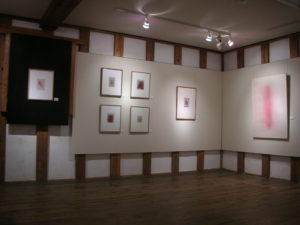
9 Hiroshi Kurita’s exhibition in Sakyukan
Through 22 years of activities, Niigata Eya has met many of those artists.
No need to say, there were lots of Niigata-based artists among them. Last autumn, due to the entry ban, we couldn’t bring those artists’ works here; but thanks to Masoud, Studio44’s amazing support, although these were copies, we were able to exhibit the Niigata-based artists’; Hiroshi Kurita, Sinzow and Momo Hasuike’s paintings at Niigata Eya’s booth in the SUPERMARKET ART FAIR 2021.
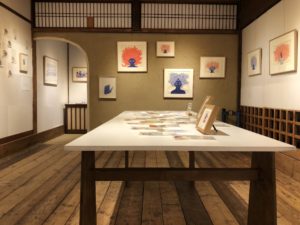
10 Momo Hasuike’s exhibition in Niigata Eya
The goal of Niigata Eya Gallery was to transform an exhibition space which had been previously monopolized by the artists group in the hierarchy system into the place where artist meets viewer individually. This was an adventure to meet the “creator” through thoroughly ensuring the individuality of “appreciation.” In Japan’s history, a gallery was born and grew up as a part of hierarchy. Niigata Eya was a movement to redefine the meaning of a gallery, focusing on the individual’s point of view.
We also publish a gallery map monthly to deliver information about exhibitions held in various galleries in Niigata city. In Japan, actually our information tool is still very much paper-oriented, not digital.
Apart from selling paintings to the local homeowners, to recreate intimate relationships between contemporary art expression and daily lives, we run a program named “eto,” which means “with paintings” in Japanese. We bring paintings to offices and hospitals for display and replace them regularly.Unfortunately, we haven’t established a concrete system that produced proper profit for the artists and us, but this activity is one of the ways to realize Niigata Eya’s purpose.
This was followed by a discussion on “International Artist Exchange Programmes- Pragmatic Advice and Strategies, with Max Presneill,” featuring UK- and US-based Max Presneill, participating in the roundtable discussion. The theme of the discussion was how to strategically engage in international cultural exchanges in the face of limited budgets, inadequate transportation of artworks, and other problems. He had developed a number of large-scale international projects. He talked about specific dos and don’ts, such as clarifying the division of roles on both sides from the beginning (I think). Andreas, who had participated until the middle of the session, recalled that there was a year when the number of participating organizations exceeded 90, and that it was over capacity. He said that this time, too, he was too busy running the fair so was not be able to talk to all the participants and that this size was the limit for him.
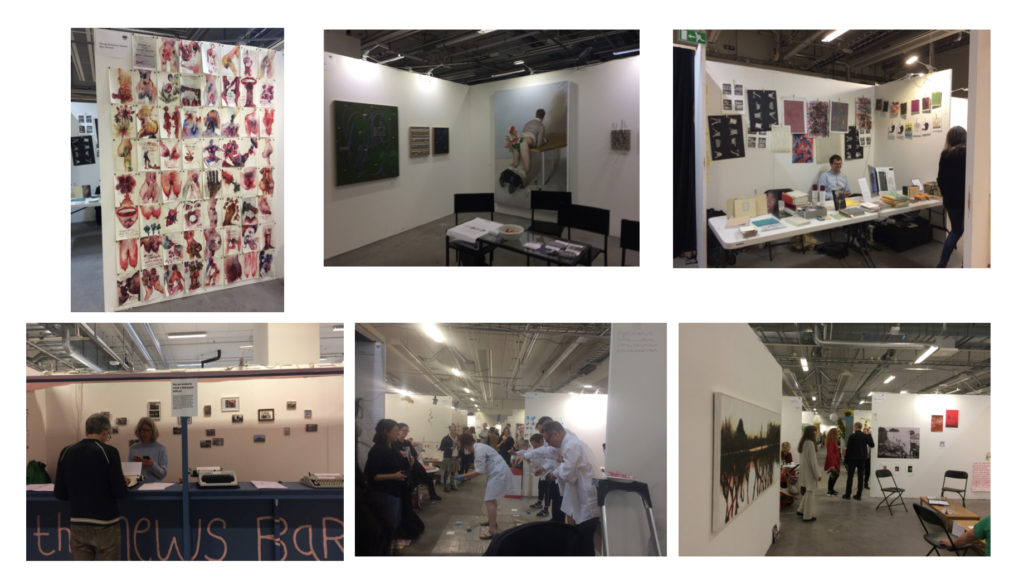
On the last day of the event, there was a live performance at the end of the day, and after the performance, everyone started to take down the exhibits as quickly as possible, as if they were professional event workers. Since there were only people who were familiar with taking down exhibits, the booths and the venue were being dismantled in no time at all. In between, everyone was busy exchanging Instagram accounts, wishing each other a happy reunion, and saying goodbye to each other. While I was idly watching the speed of the crowd, Secil and Zeynep invited me to Gamla stan, as it was the last night of the event.
Secil and Zeynep invited me to Gamla stan, as it was the last night of the event. We strolled through the old town, which was still bright, even after 8 p.m., and the excitement of the cityscape melted away my fatigue. We shared a toast at Temple Bar, a sports bar that doesn’t even have a hint of “Temple” about it, with the two people who have been so kind to me throughout the art fair. Then the fair came to an end.
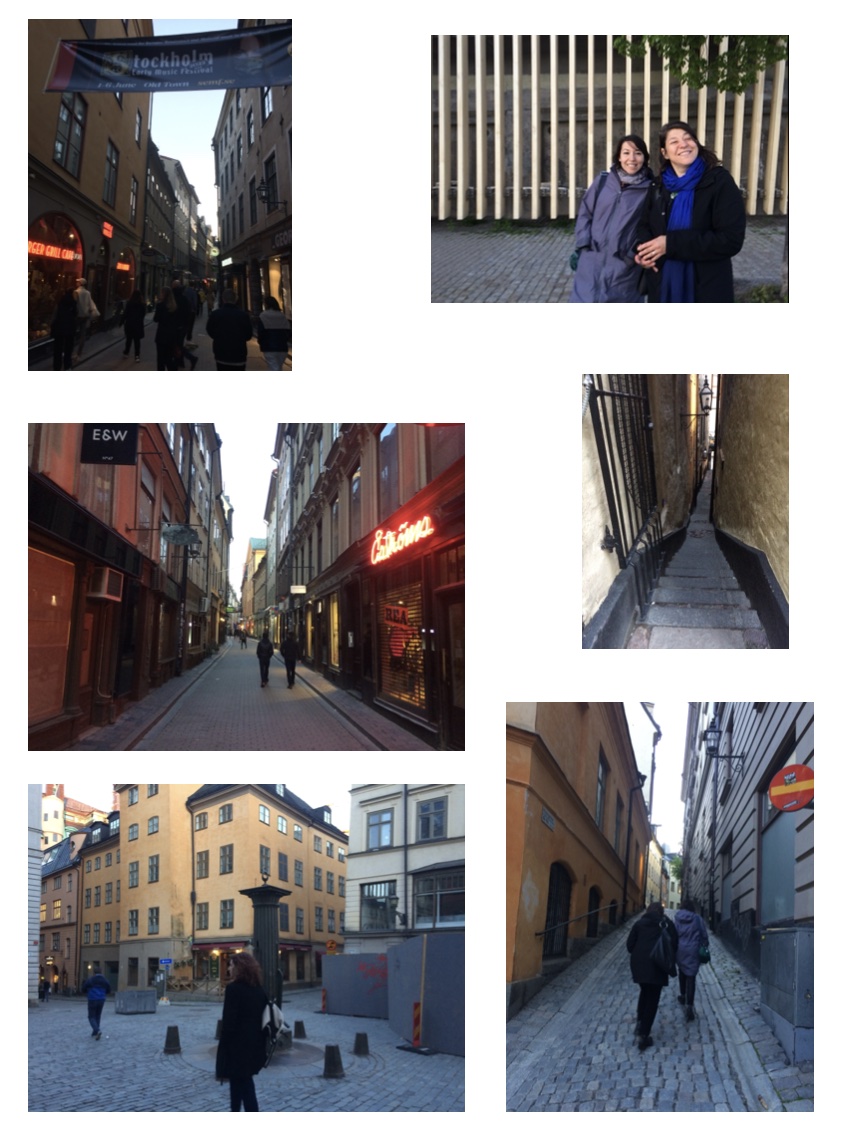
Conclusion
Since I was in tight crowds and exchanged words close up with so many people during my stay, it would not have been surprising if I had contracted the new coronavirus. But I did not, so it was a perfect trip with a good ending. I thought of it as a “mobile booth” instead of exhibiting at the art fair, and carried with me art books and files of the works of three Niigata-based artists, but the timing was difficult and I feel sorry that I could not introduce them as much as I had hoped. I wish I could have had the opportunity to show their works in person at the booth. Still, in those few opportunities I had, I showed Hiroshi Kurita‘s art book to some artists and I was very happy to hear directly from Hans Overvliet of RuimteCARSUUR in Middelburg, the Netherlands, who said, “I was exhausted, but all my fatigue was gone in one fell swoop,“ and Johan Sandstrom of Molekyl gallery in Malmo, Sweden, wore an expression that showed his great pleasure. Nowadays, exchanging accounts on social networking services, such as Instagram, has replaced the exchange of business cards, allowing people to follow each other’s activities. In addition to the aforementioned Madhat Kakei‘s exhibition to be held at the Sakyukan September in 2023, we have received an offer from Hans from the Netherlands to hold Hiroshi Kurita’s exhibition at ruimteCARSUUR and an exhibition by a Dutch artist at Niigata Eya. Johan from Molekyl gallery in Malmö said that my impression that culture (policy) in Sweden has become a common national perception was surprising. His impression is that Sweden is a technocratic country, and that even art tends to be functional/rational in nature. I was grateful to hear from someone who actually lives in Sweden, as I could only get a superficial impression during my short stay in Stockholm. With Johan, we will begin the correspondence email project to get to know each culture more by introducing artists and their activities around us. We are also exploring the possibility of an exchange exhibition with Studio44, which has been very kind to us and with whom we have deepened our friendship. I also introduced Andreas to the “Sumida Yashima Hana Bunka Souzou Ku” (Sumida Yashima Flower Culture Creation District) in Sumida-ward, Tokyo, which has been working to combine the utilization of vacant houses and artist-run programs, including the “Mukojima Expo” for next year’s Art Fair. This was literally the third challenge for me to visit Sweden. I was thinking only of fulfilling my mission without incident, but now that it is over, it is not the end but the beginning; the balls that will lead to the future are flying in from everywhere, and I am desperately trying to throw them back. Remote meetings are increasing due to the pandemic, and while that is convenient in this world, however, the possibilities that meeting, talking, and getting to know a person, even just once, can bring are greater than I had imagined. In particular, art fairs, where “colleagues,” so to speak, who are individually developing their own activities in their respective locations, gather for the purpose of networking, have an immeasurable impact even if they are only there for a few days. I sincerely express my respect to the three creative directors who organize such a large-scale art fair every year, which requires enormous effort, energy, time, and patience. I would also like to express my sincere gratitude to IASPIS and Scandinavian Japan Sasakawa Foundation for giving us the opportunity to meet them.
English translation was polished by Ron Takata
▶ SUPERMARKET 2022 Report(Japanese edition)
▶ SUPERMARKET 2021(Japanese)
▶ SUPERMARKET 2020(Japanese)

